Abstract
1. Inward currents in chromaffin cells were studied with the patch-clamp technique (Hamill, Marty, Neher, Sakmann & Sigworth, 1981). The intracellular solution contained 120 mM-Cs+ and 20 mM-tetraethylammonium (TEA+). Na+ currents were studied after blockade of Ca2+ channels with 1 mM-Co2+ applied externally. Ca2+ currents were recorded after eliminating Na+ currents with tetrodotoxin (TTX). The current recordings were obtained in cell-attached, outside-out and whole-cell recording configurations (Hamill et al. 1981).
2. Single channel measurements gave an elementary current amplitude of 1 pA at -10 mV for Na+ channels. This amplitude increased with hyperpolarization between -10 and -40 mV, but did not vary significantly between -40 and -70 mV.
3. The mean Na+ channel open time was 1 ms at -30 mV. This open time decreased both with depolarization and hyperpolarization. Its value was close to the time constant of inactivation, τh, above -20 mV.
4. Ensemble fluctuation analysis of Na+ currents gave results consistent with those of single channel measurements. Noise power spectra obtained between -35 mV and 0 mV could be fitted with a single Lorentzian. A range of Na+ channel densities of 1·5-10 channels per μm2 was calculated.
5. Cell-attached single Ca2+ channel recordings were obtained in isotonic BaCl2 solution. The single channel amplitude was 0·9 pA at -5 mV, and it became smaller for positive potential values.
6. At -5 mV, single Ba2+ currents appeared as bursts of 1·9 ms mean duration containing on the average 0·6 short gaps. The burst duration was larger at positive potentials.
7. Ensemble fluctuation analysis of Ca2+ channels was performed on whole-cell recordings in external solutions containing isotonic BaCl2 or external Ca2+ (Cao) concentrations of 1 and 5 mM. The unit amplitude calculated in the former case was similar to that obtained in single channel measurements.
8. Noise power spectra of Ca2+ or Ba2+ currents could be fitted by the sum of two, but not one, Lorentzian components.
9. Tail currents could be fitted by the sum of two exponential components. The corresponding time constants had values close to those obtained with noise analysis.
10. The rising phase of Ca2+ and Ba2+ currents was sigmoid. It could be fitted by the sum of three exponentials. The time constant of the largest amplitude component, τ1, was similar to the time constants of the slow component observed in noise and tail experiments. This time constant also corresponded to the burst duration obtained in single channel measurements.
11. The value of τ1 was larger in 5 mM-Cao and in isotonic Ba2+ than in 5 mM-Bao. Thus, the kinetic properties of Ca2+ channels depend on the nature and concentration of the permeating ion.
12. A simple kinetic scheme is proposed to model the activation pathway of Ca2+ channels.
13. Currents in 1 mM-Cao and 5 mM-Cao showed clear reversals around +53 mV and +64 mV respectively. The outward currents observed above these potentials are most probably due to Cs+ ions flowing through Ca2+ channels.
14. The instantaneous current—voltage relation was obtained from tail current data in the range -70 to +100 mV in 5 mM-Cao. The resulting curve displayed an inflexion point around the reversal potential.
15. Very little inactivation of Ca2+ currents was observed. However, a slow current decline was observed in some cells above +10 mV.
16. Conditioning prepulses to positive potentials had potentiating or depressing effects on Ca2+ currents depending on whether the test pulse lay below or above the maximal current potential. The potentiating effect may be linked to the slowest component of the current rise observed below +10 mV. The depressing effect may be related to the slow decline obtained above +10 mV.
17. Analysis of ensemble variance and of tail current amplitudes suggested that the opening probability of Ca2+ channels was at least 0·9 above +40 mV.
18. A slow rundown of Ca2+ currents was observed in whole-cell recordings. The speed of the rundown was dependent on intracellular Ca2+ concentration. The rundown was apparently due to a progressive elimination of the channels available for activation.
19. The density of Ca2+ channels (before rundown) was estimated at 5-15/μm2.
20. In cell-attached experiments, inward current channels were often seen to follow action potentials. These events did not appear to be the usual Na+ and Ca2+ currents. They were probably due to cation influx of either Na+ or Ba2+, depending on the pipette solution, through Ca2+-dependent channels. Voltage-independent single channel activity observed in whole-cell and outside-out recordings may be due to the same channels.
Full text
PDF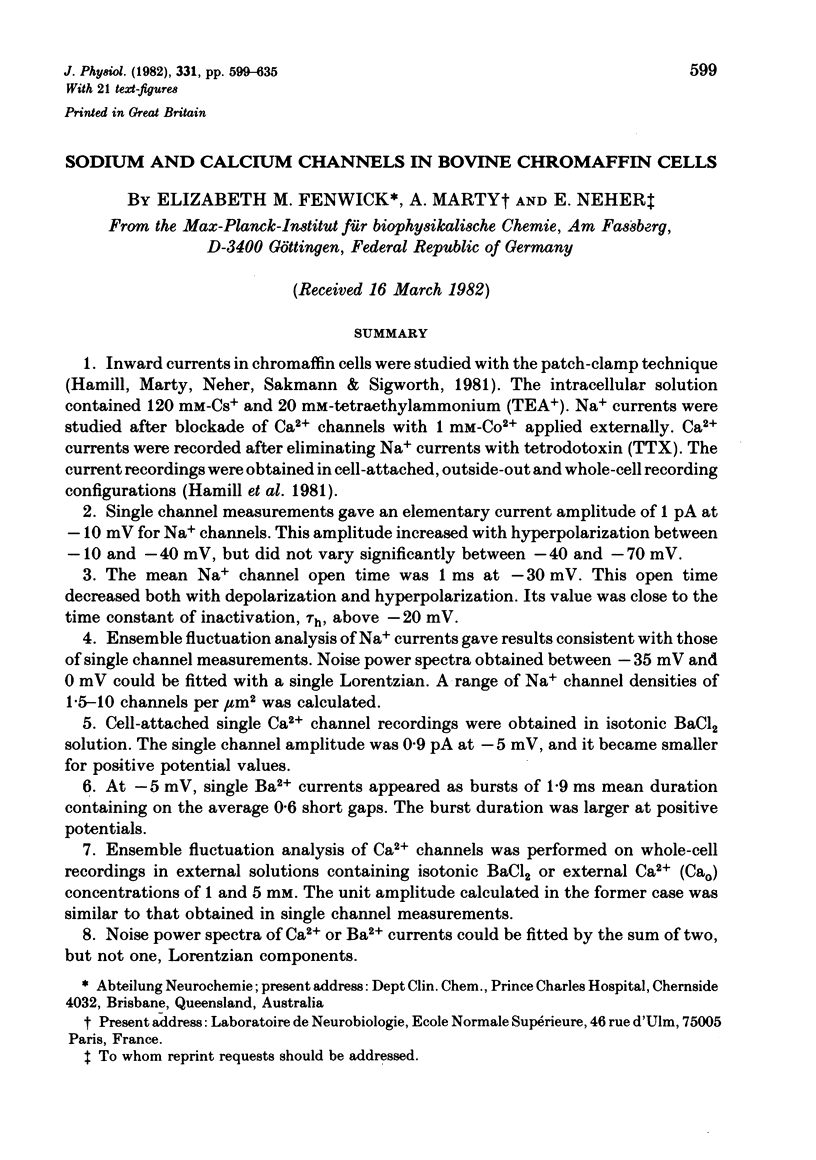
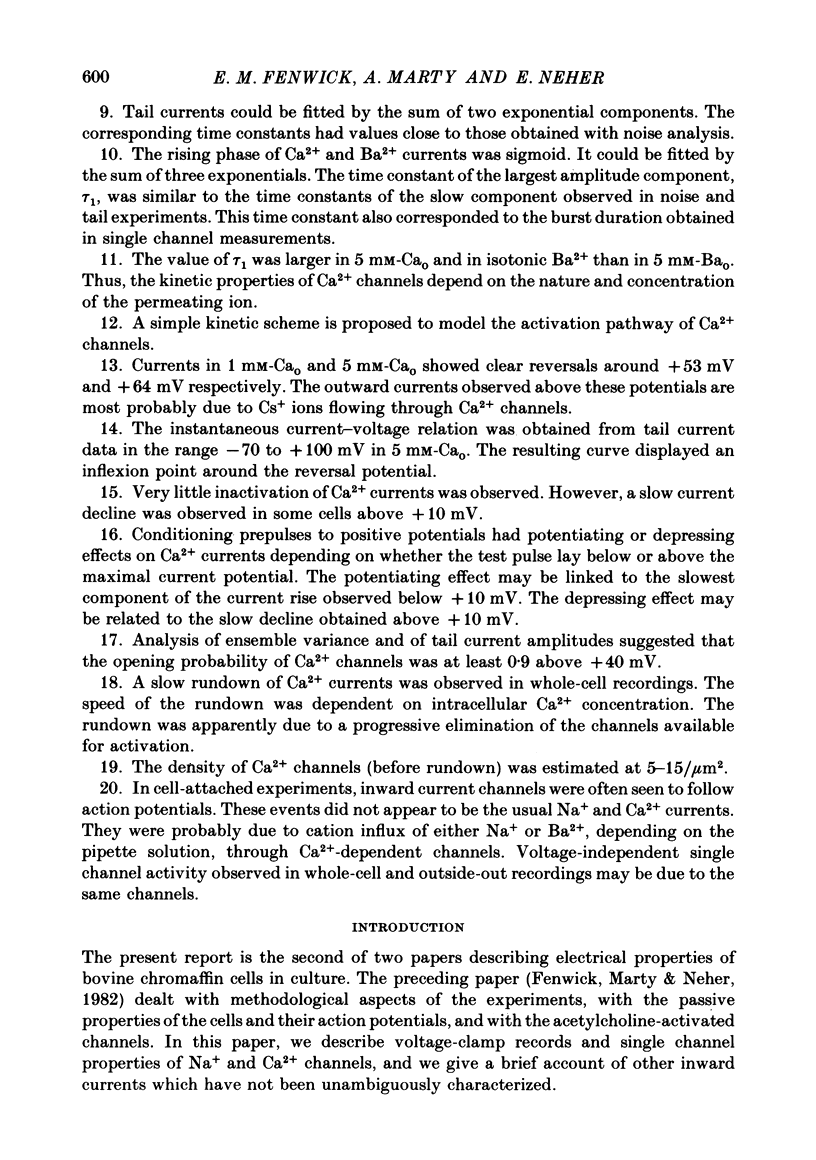
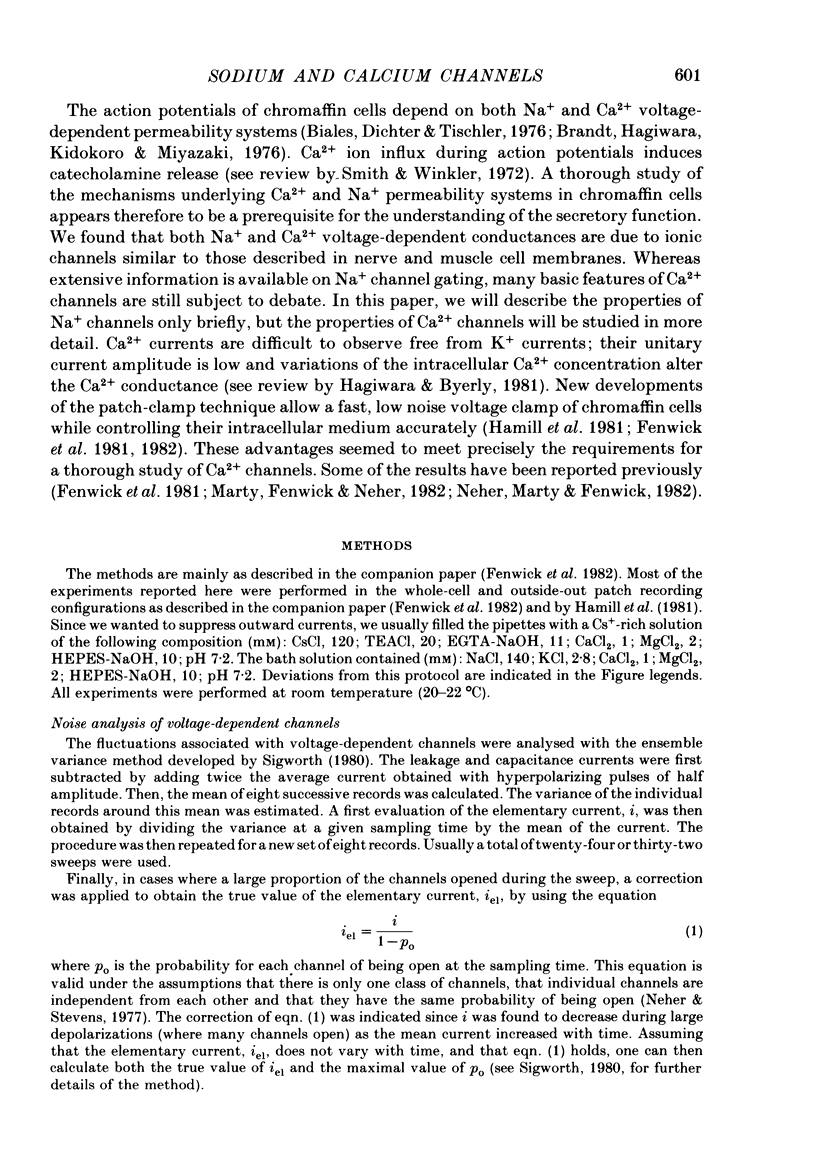
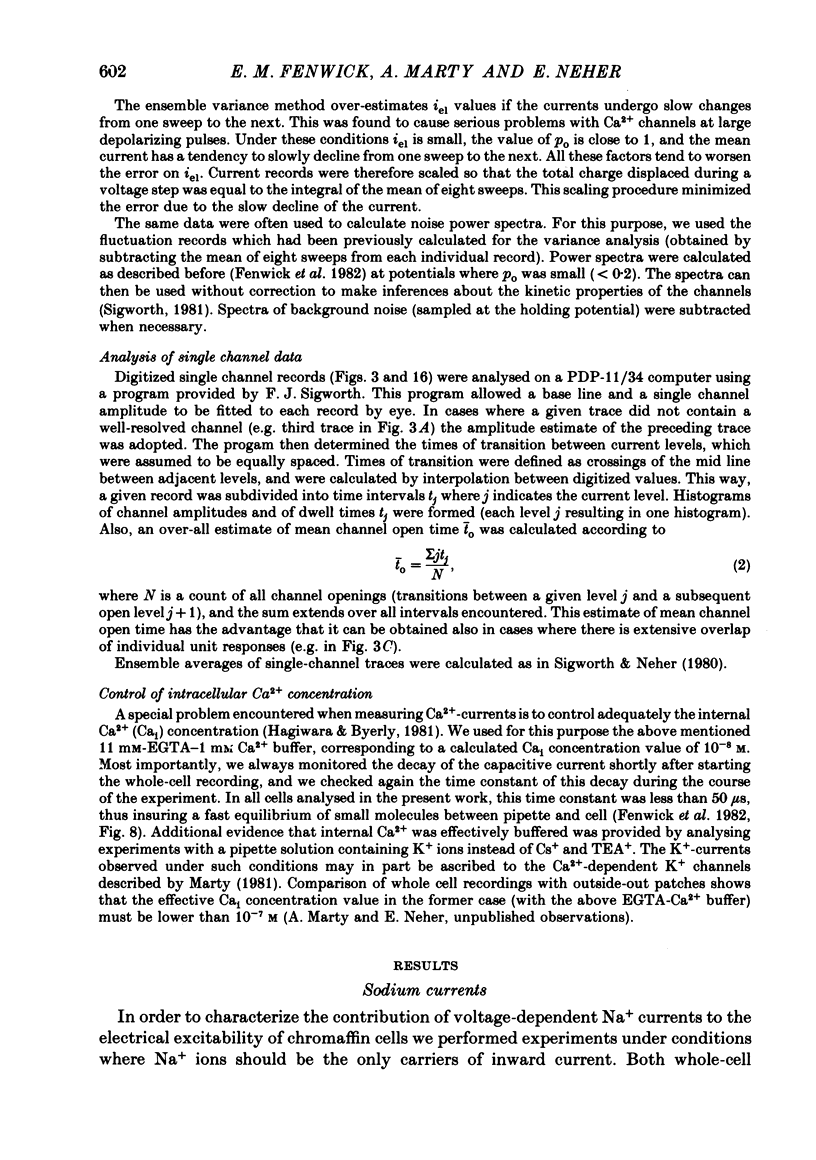
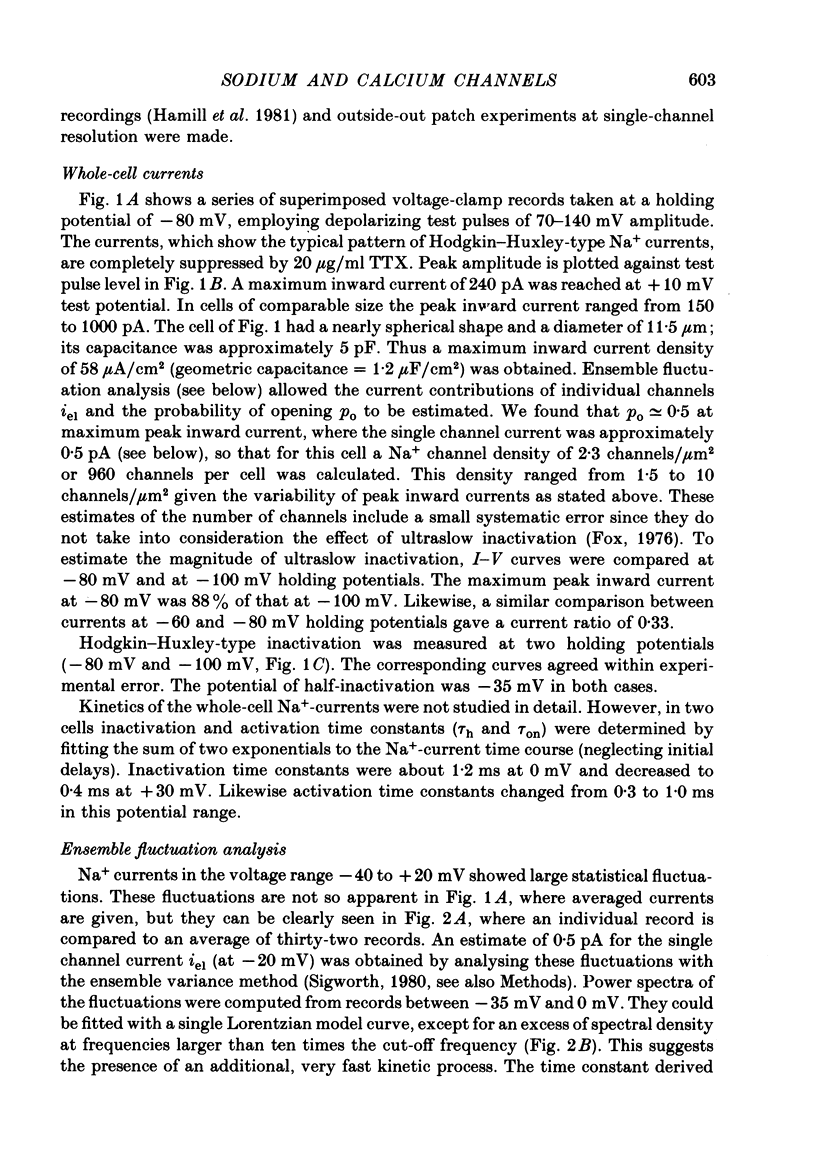
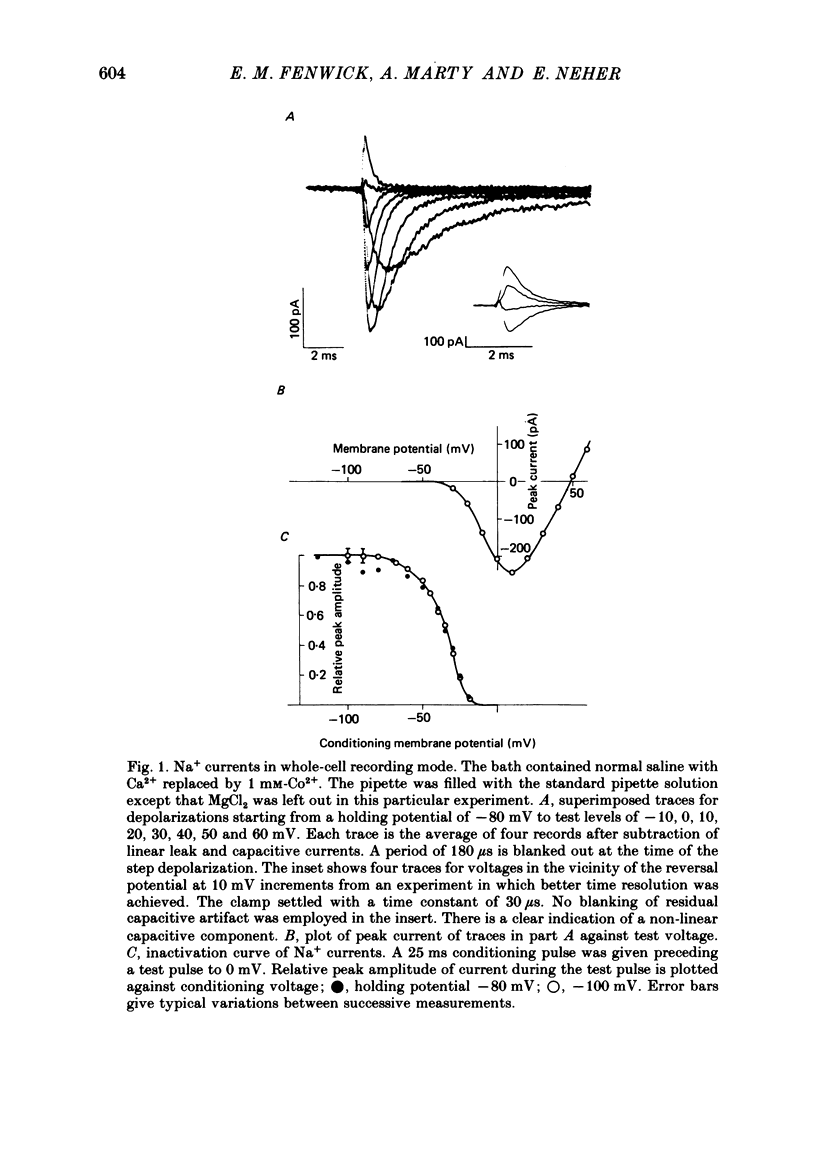
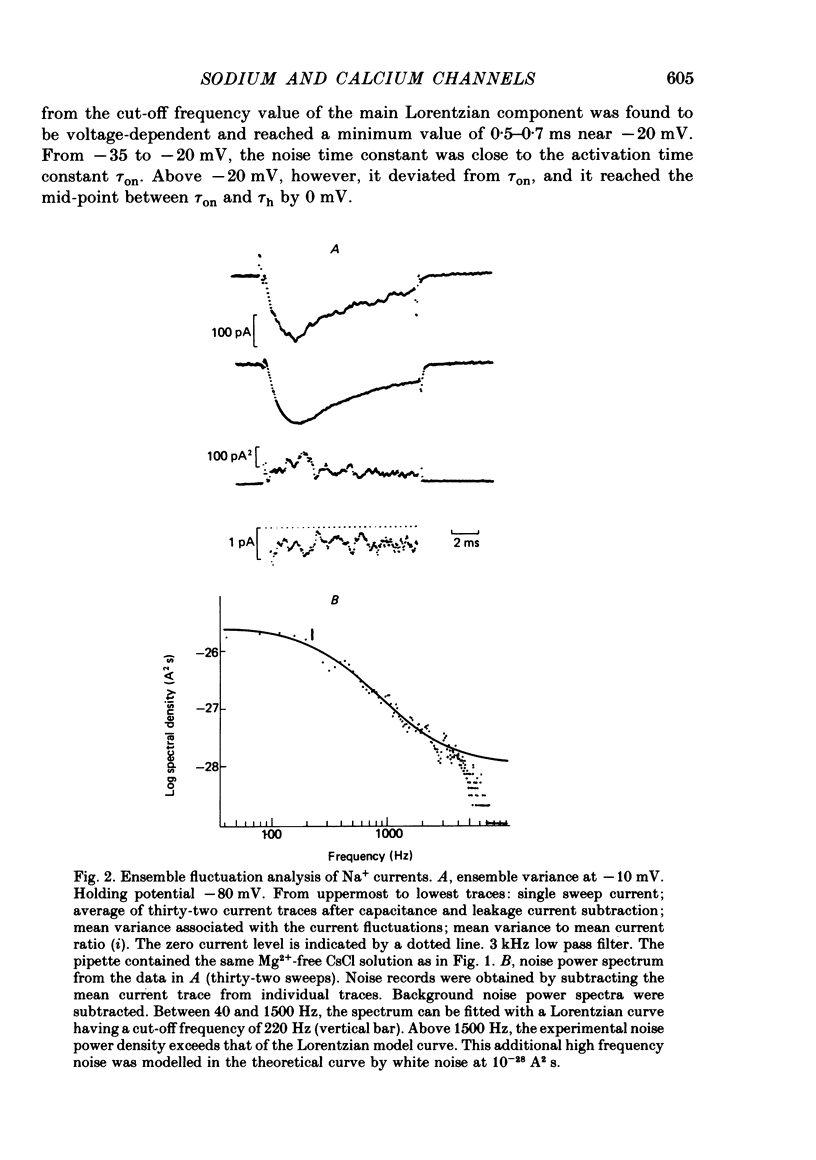
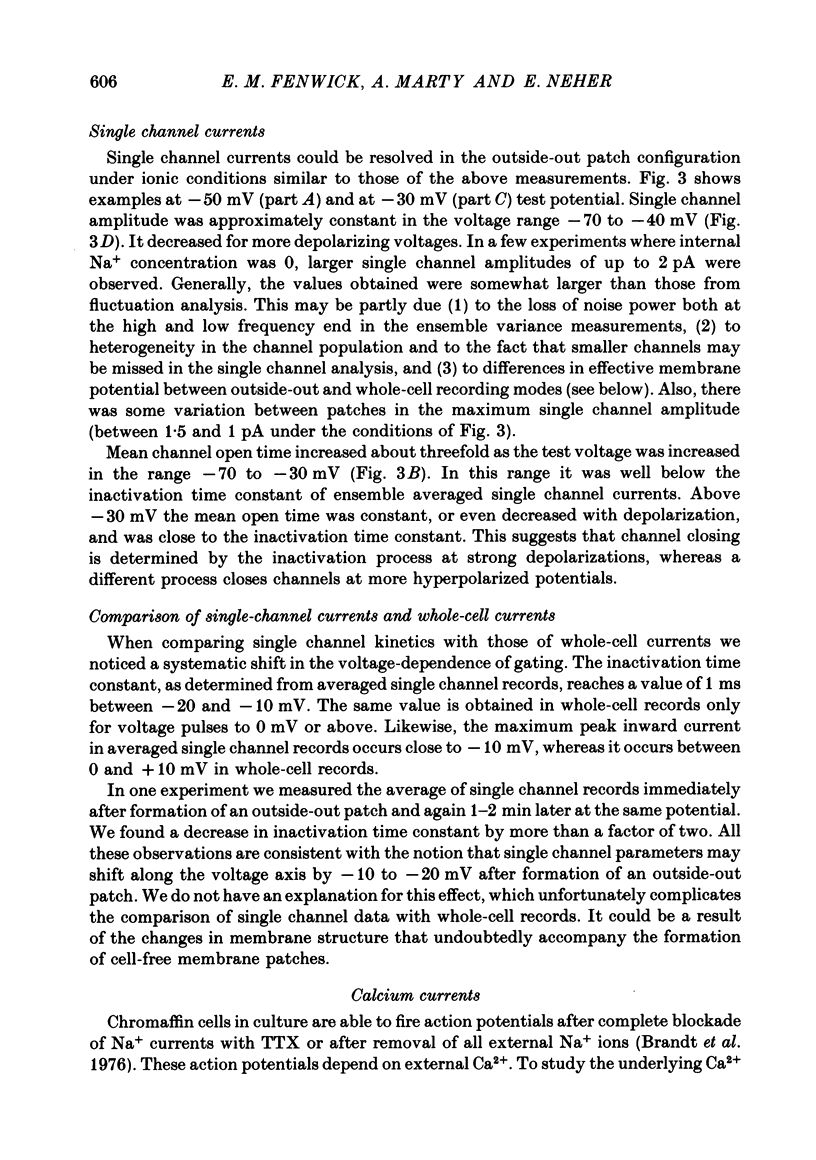
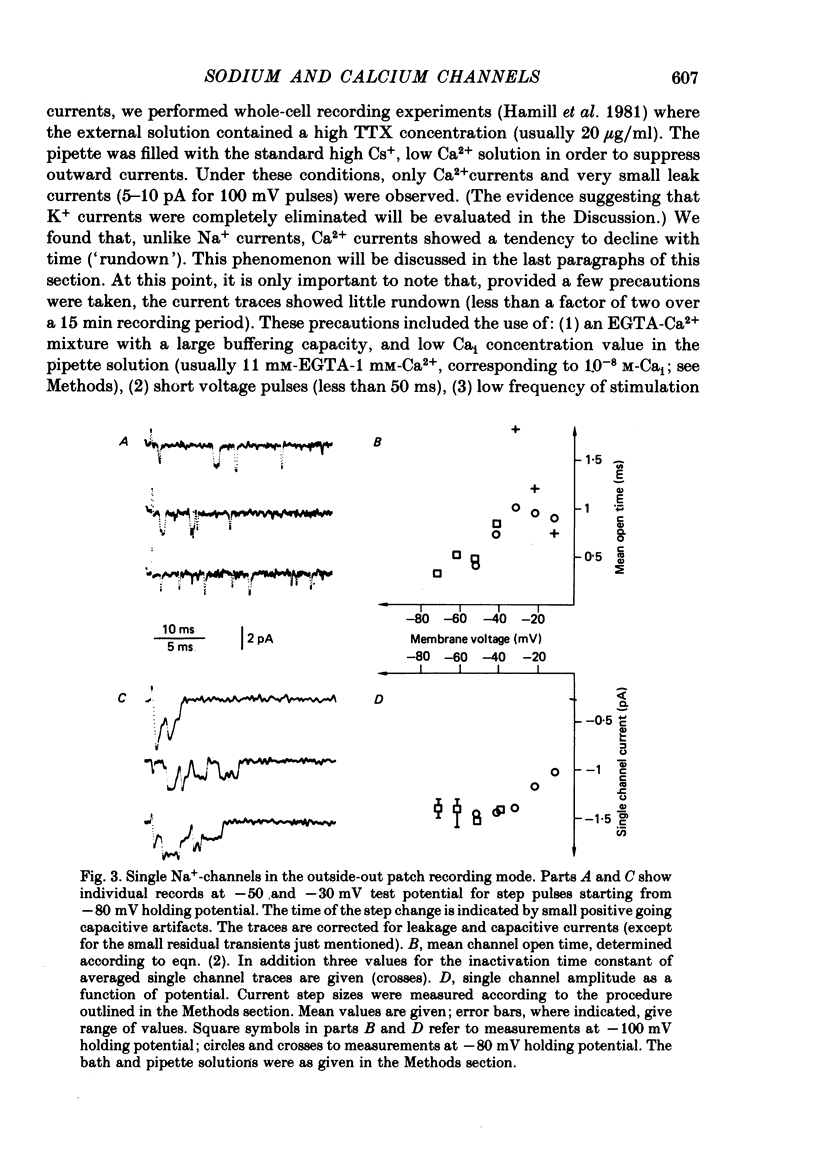
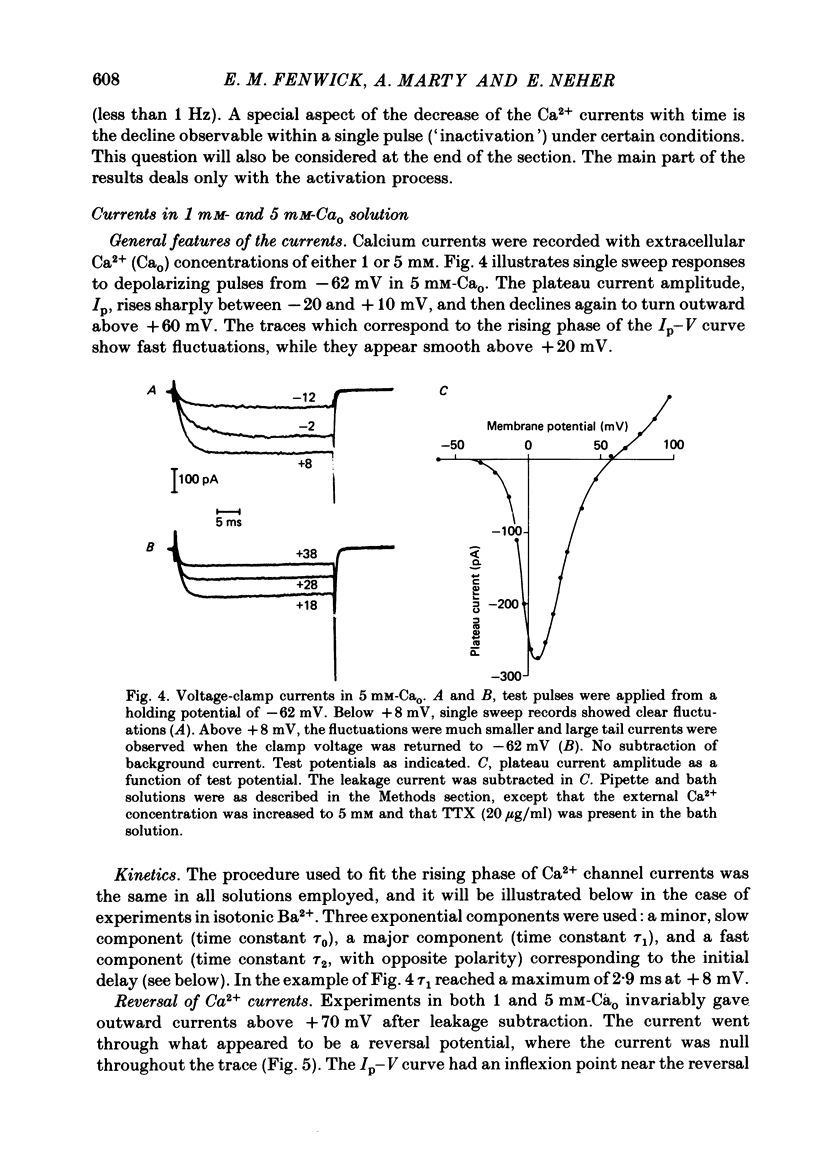
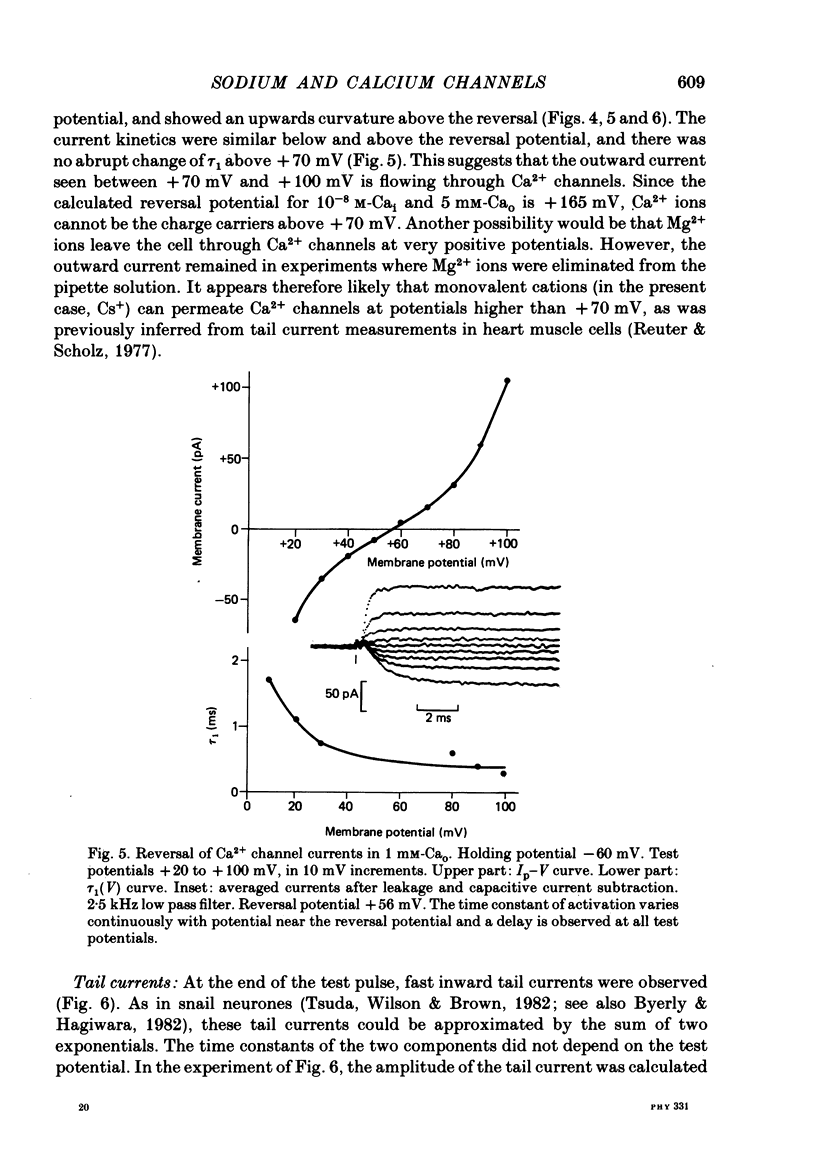
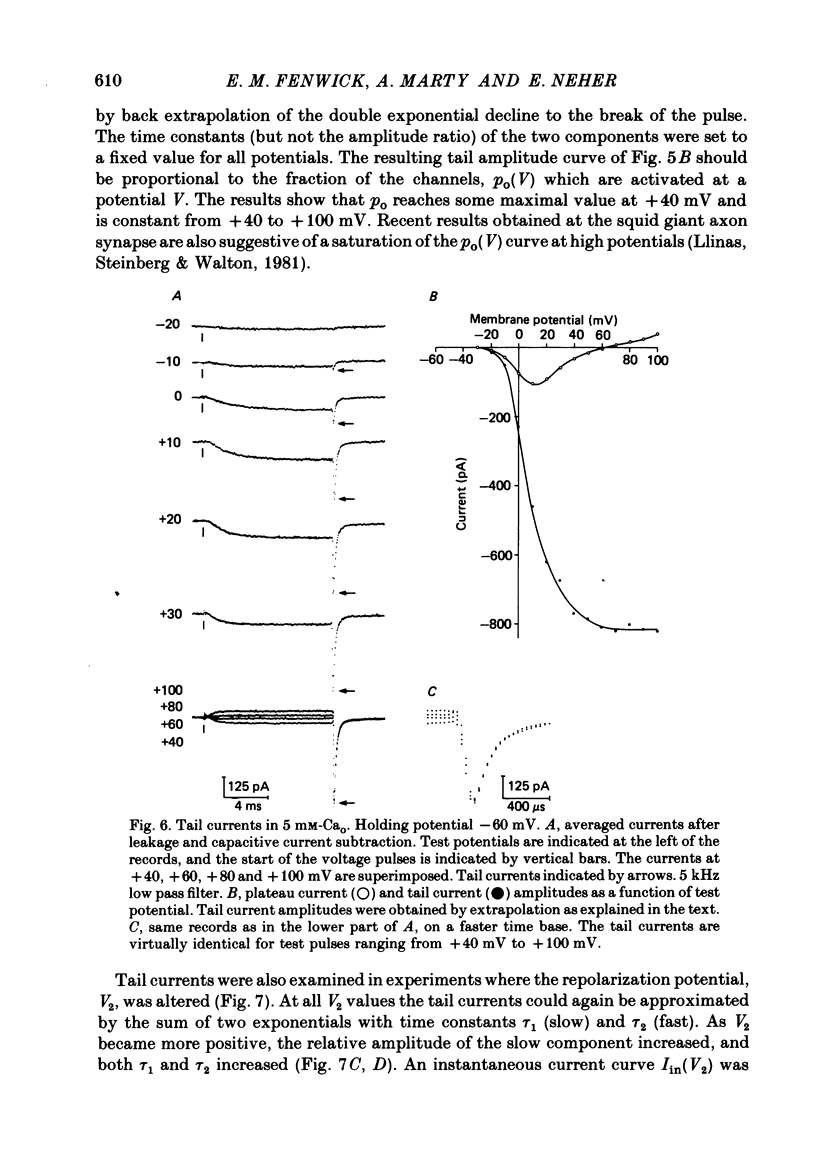
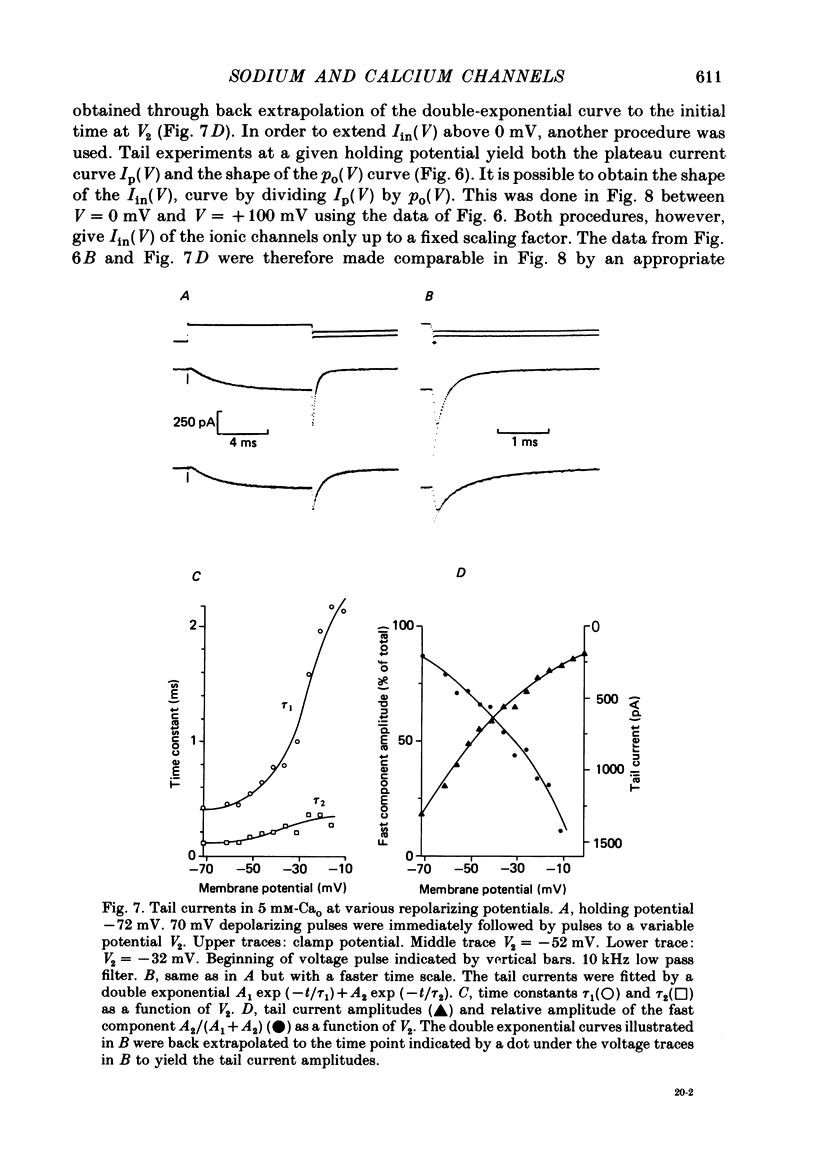
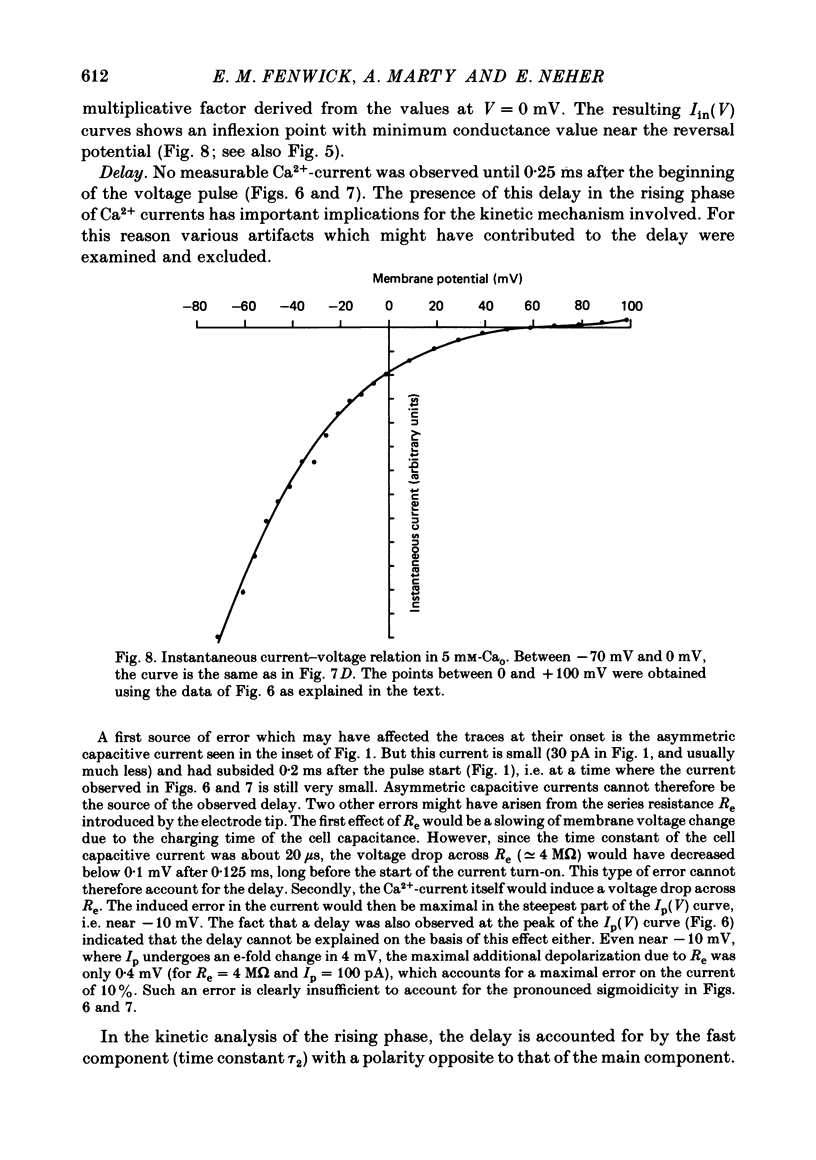
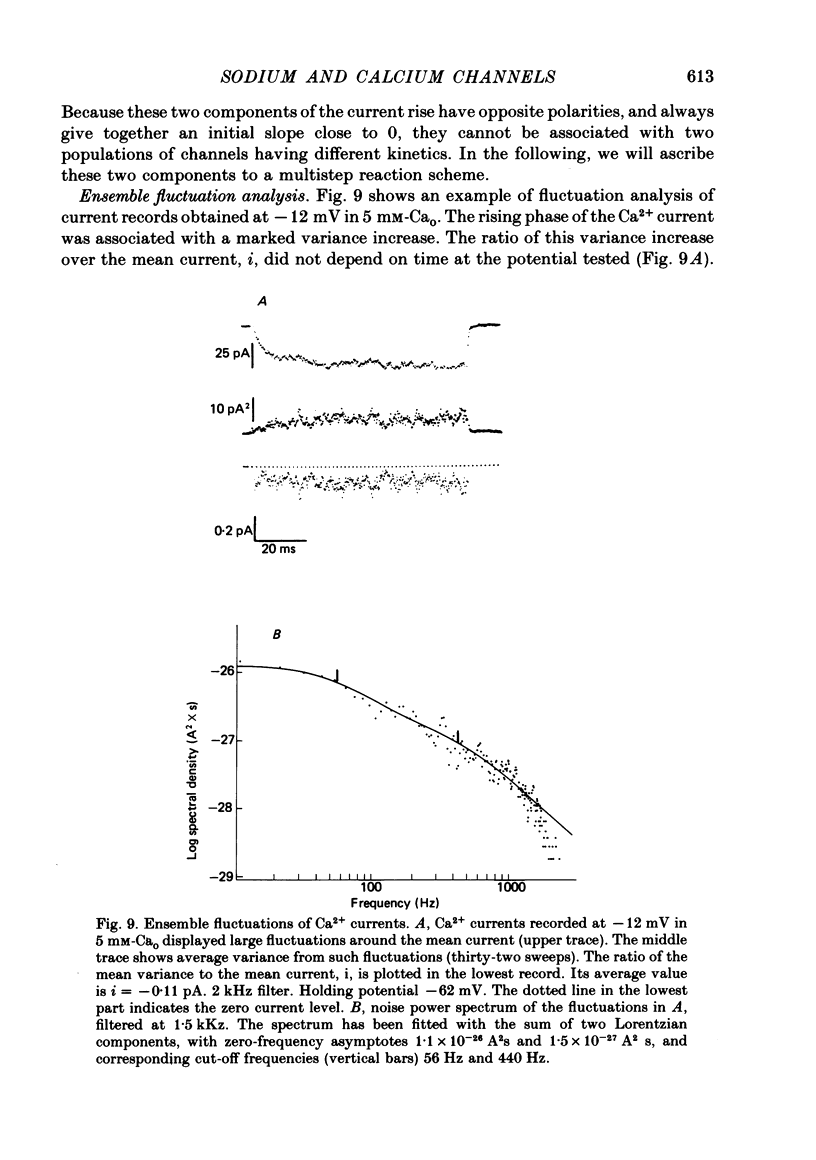
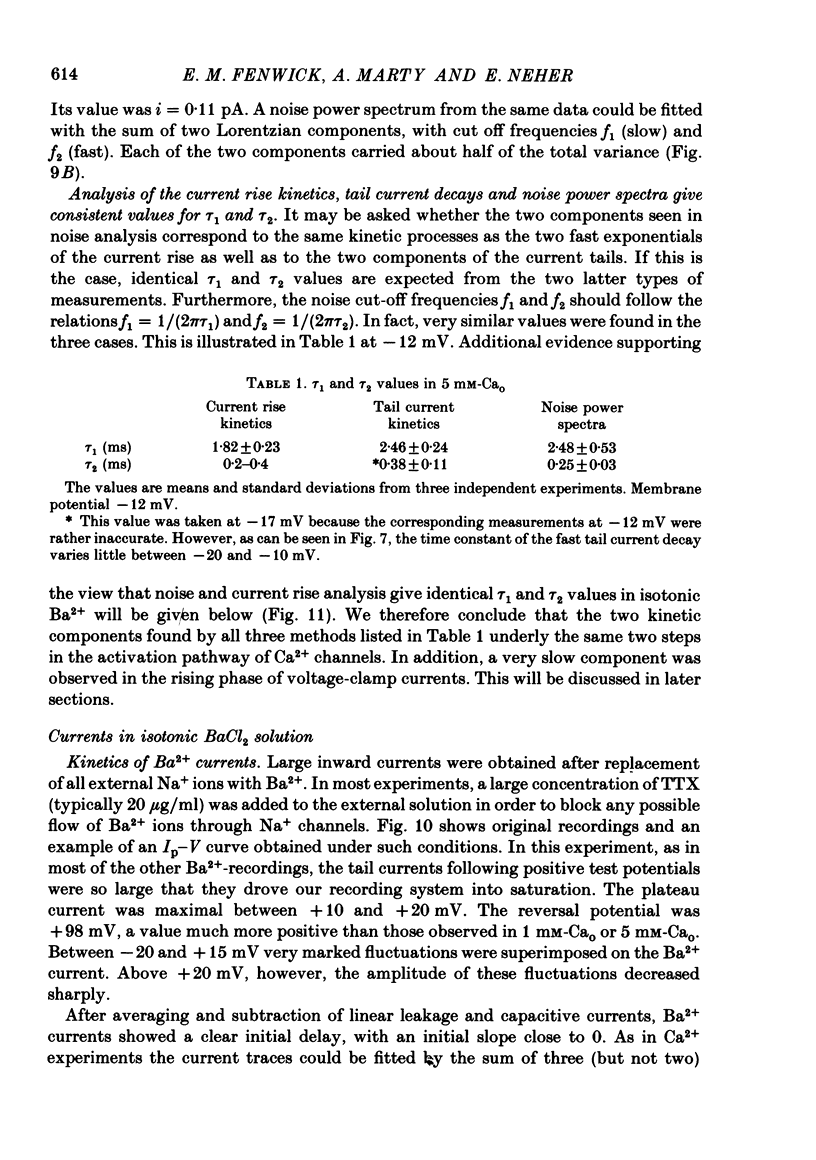
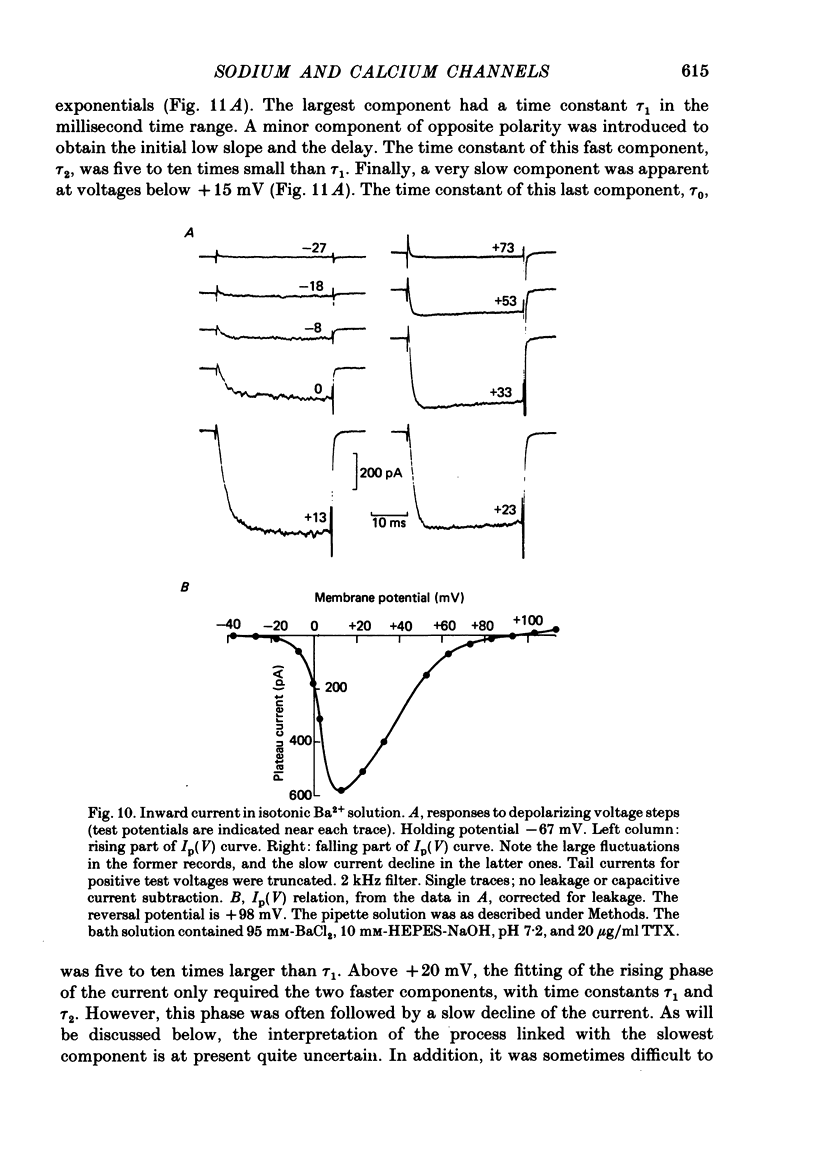
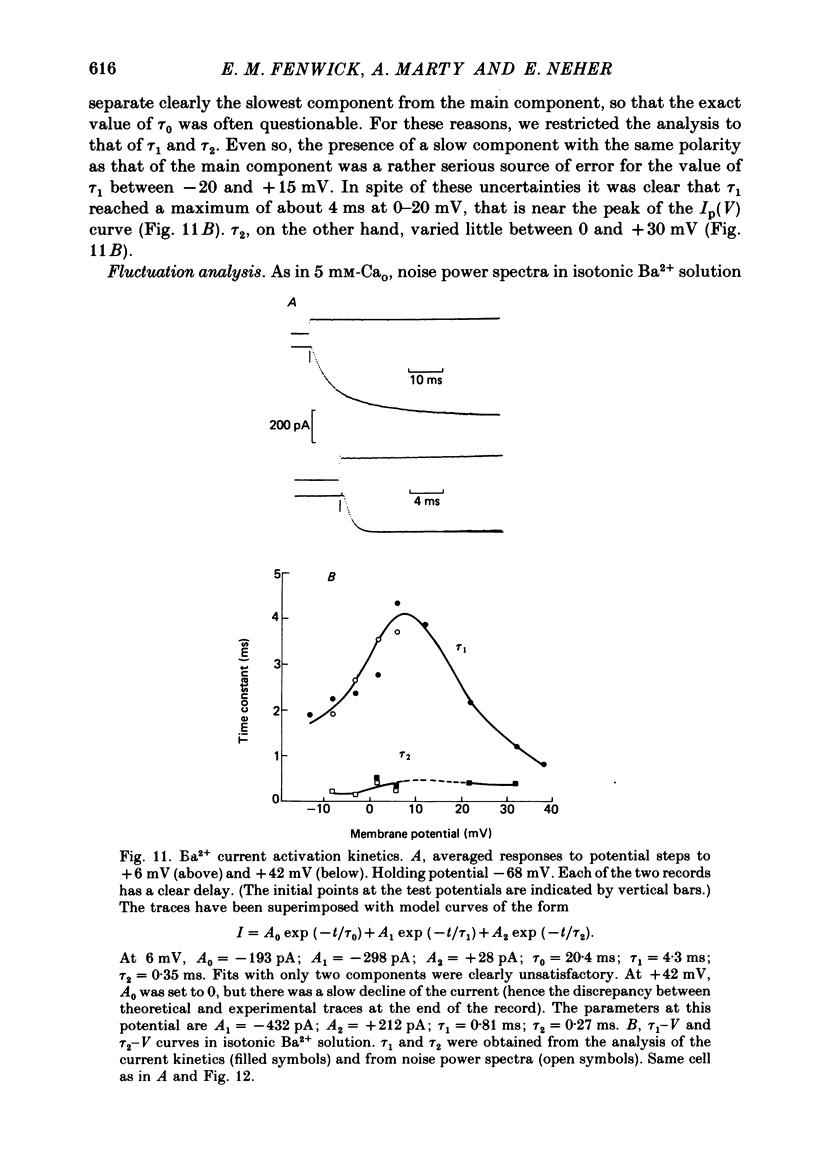
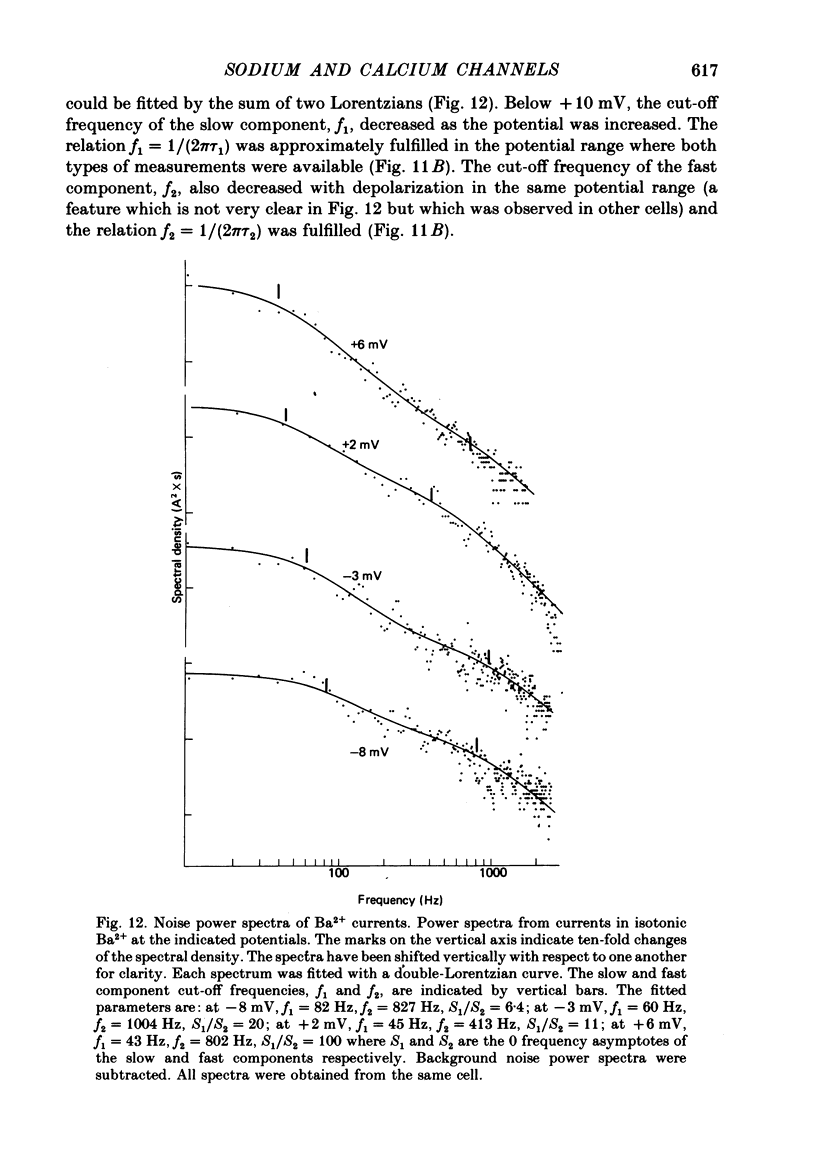
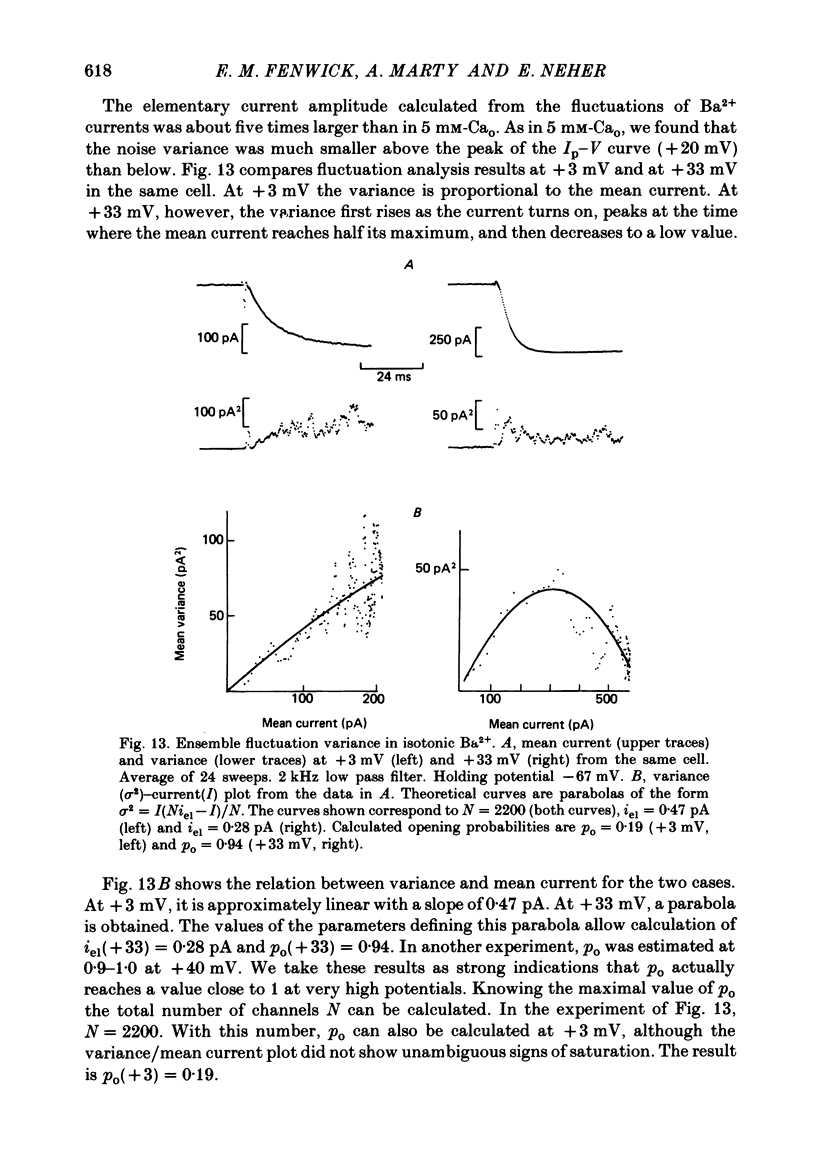
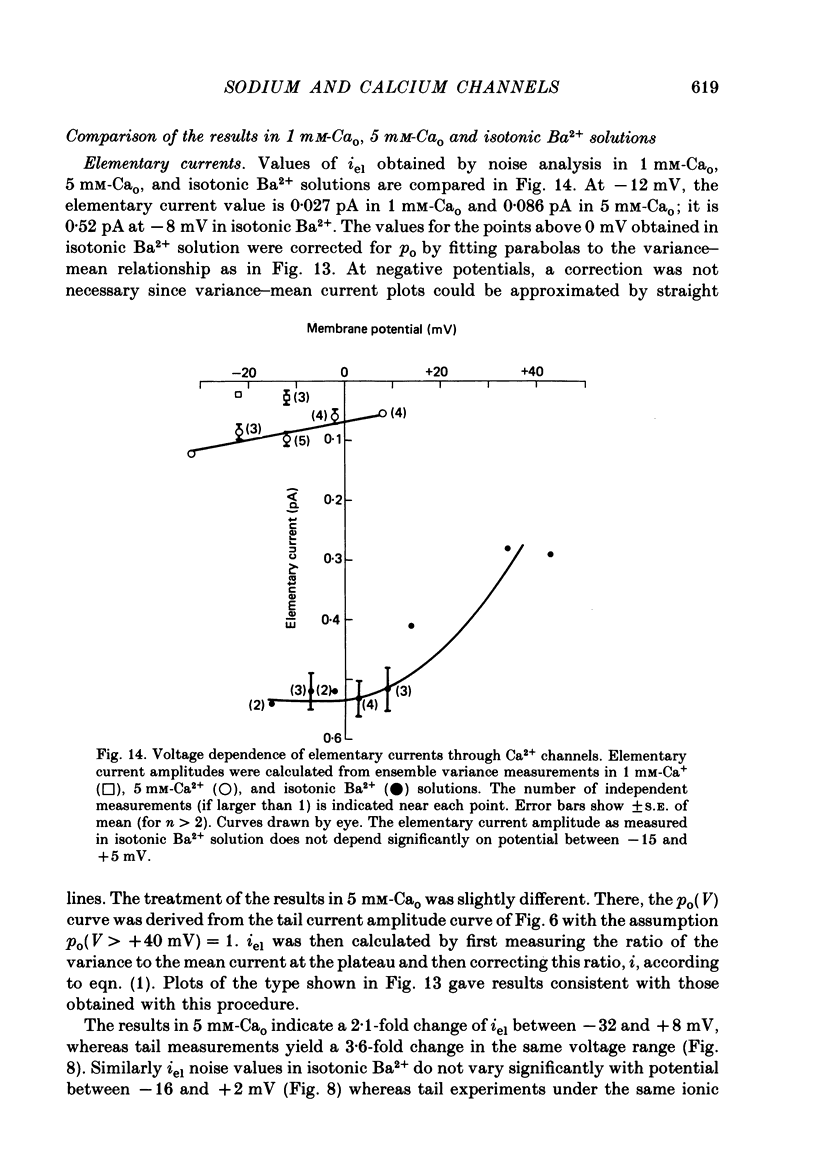
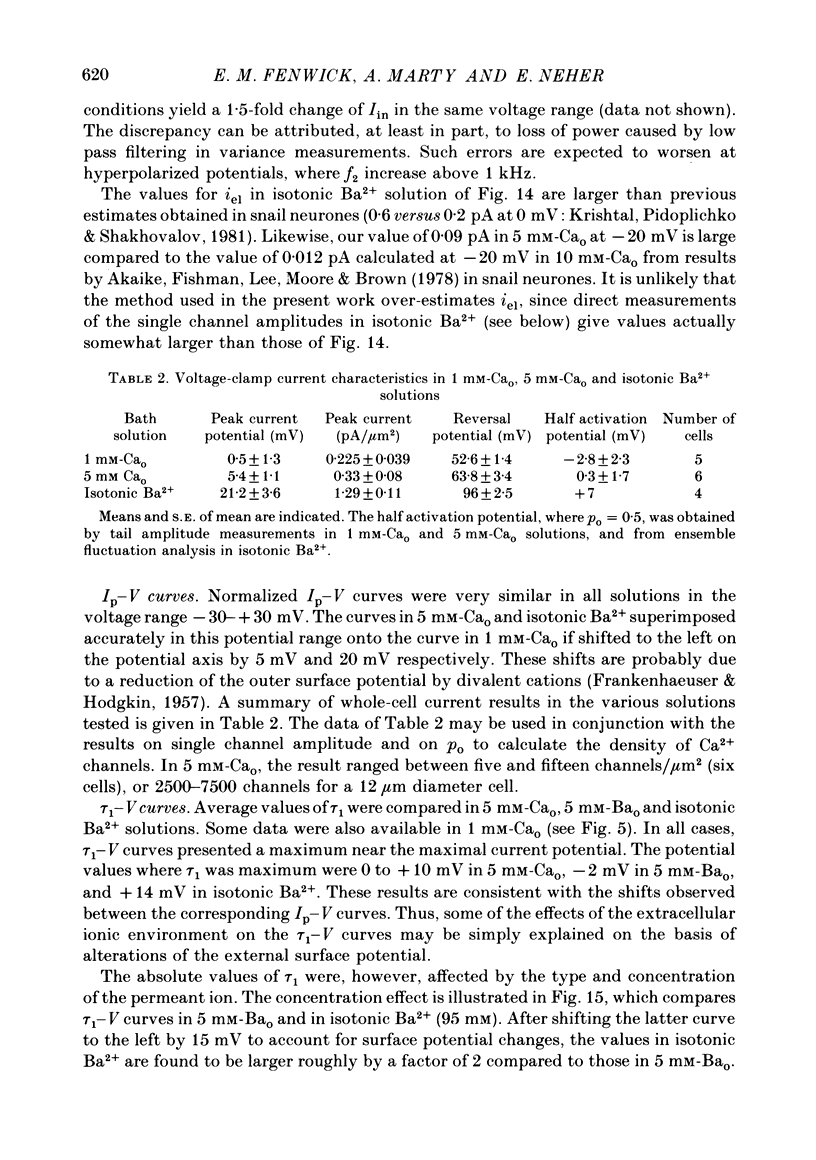
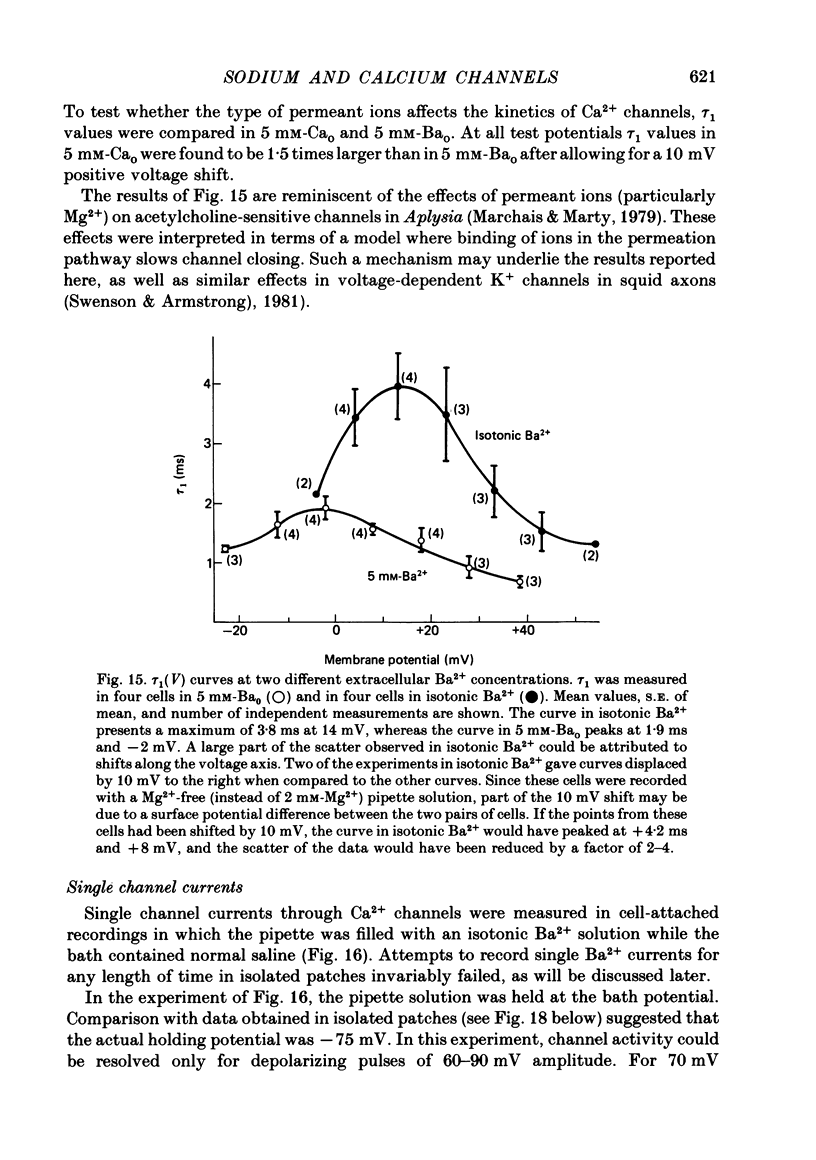
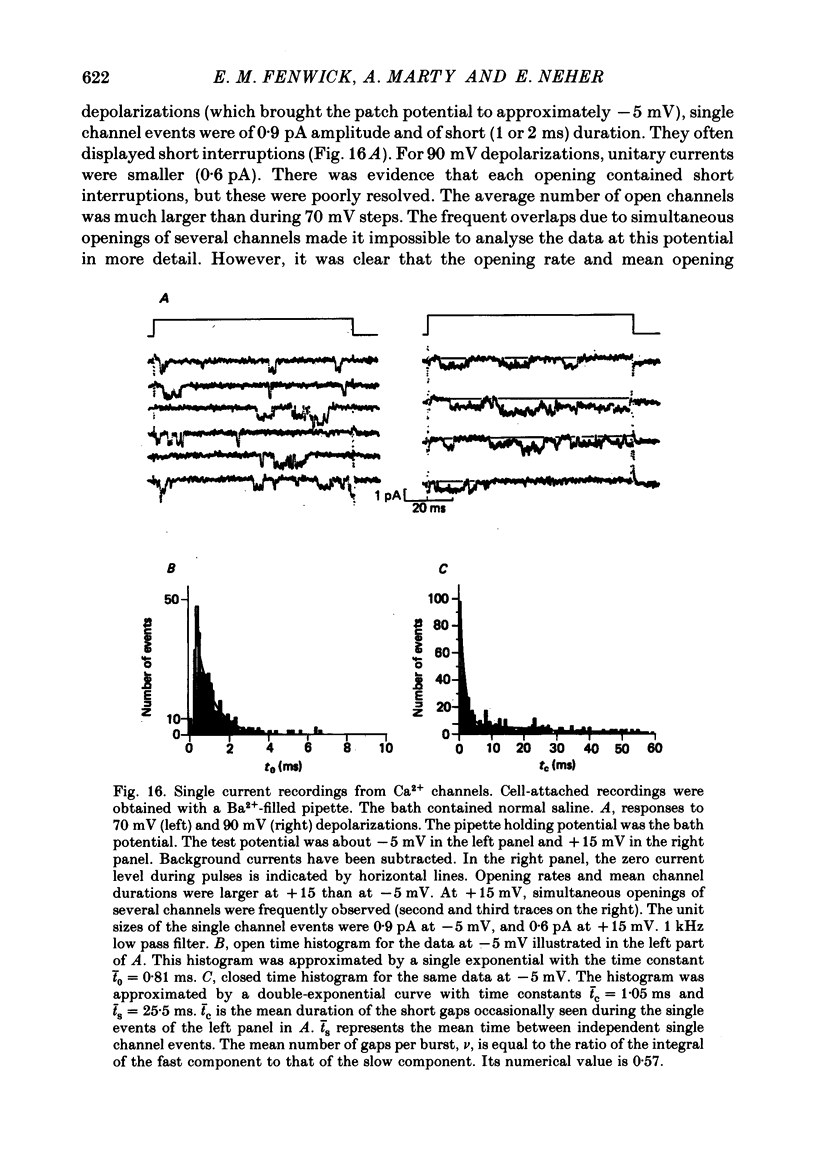
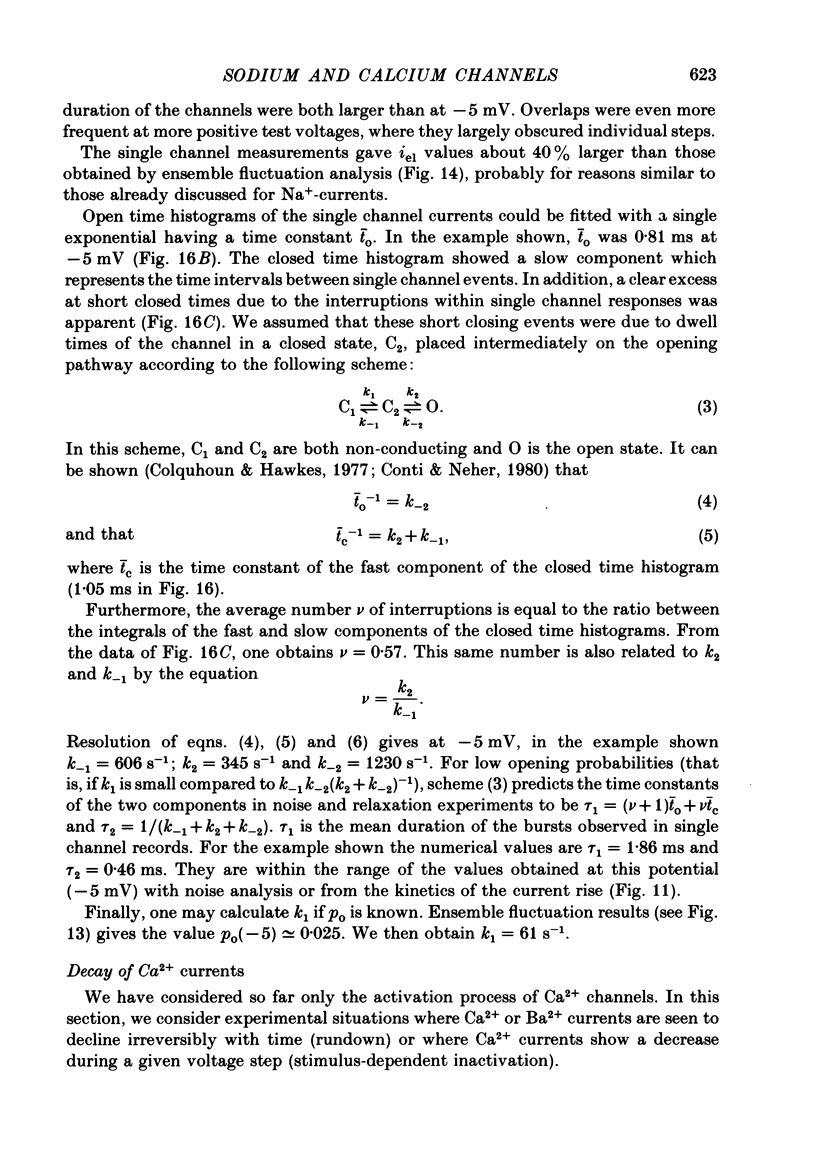
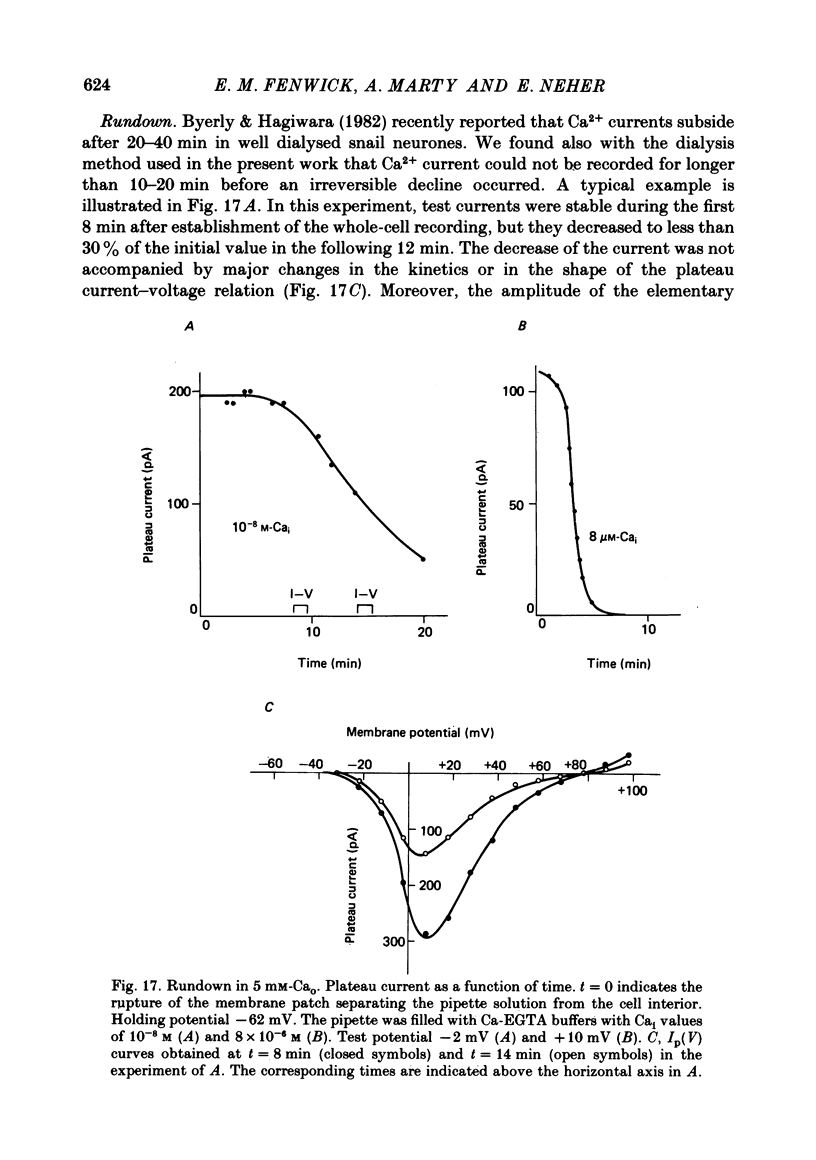
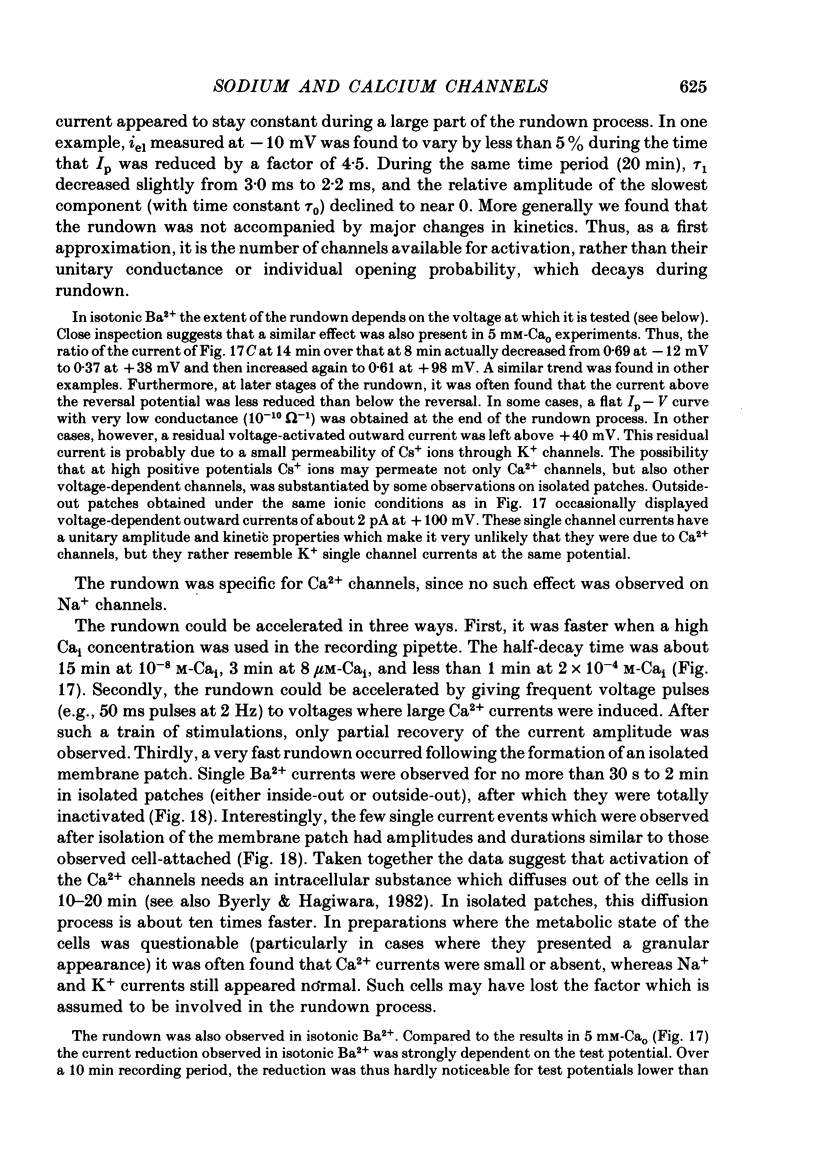
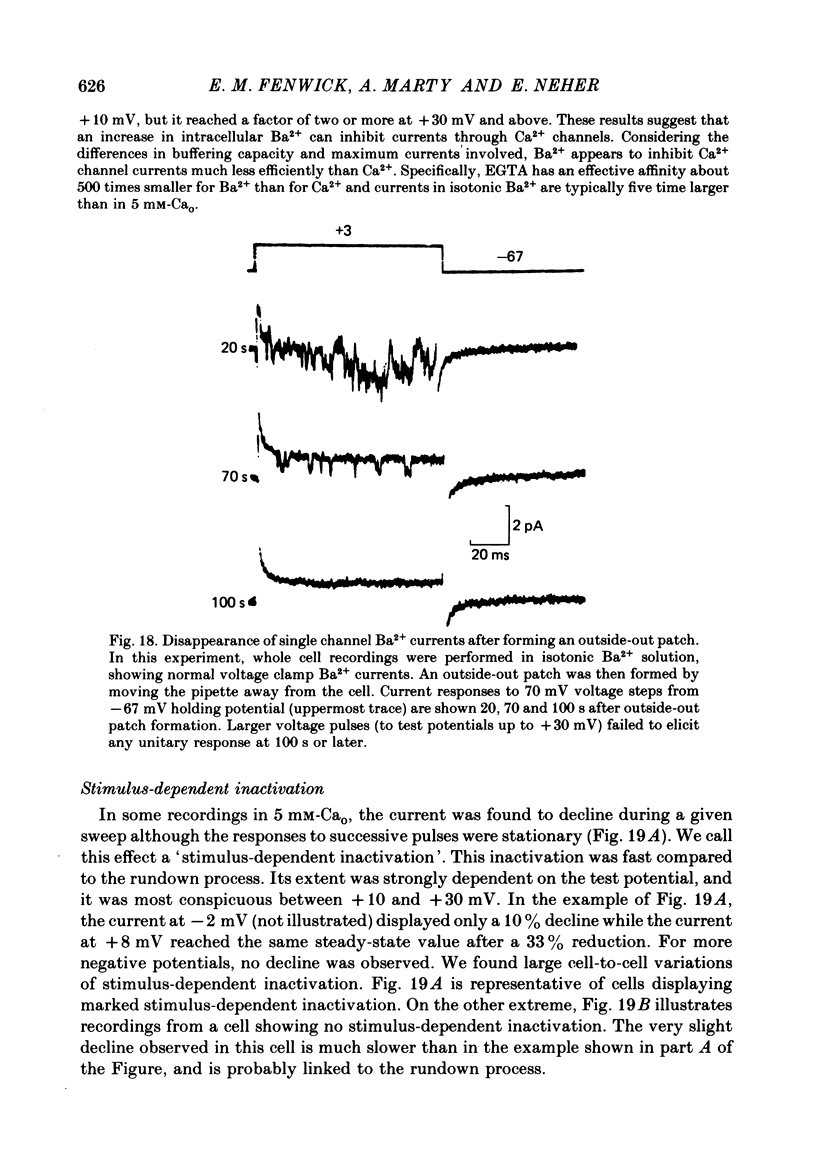
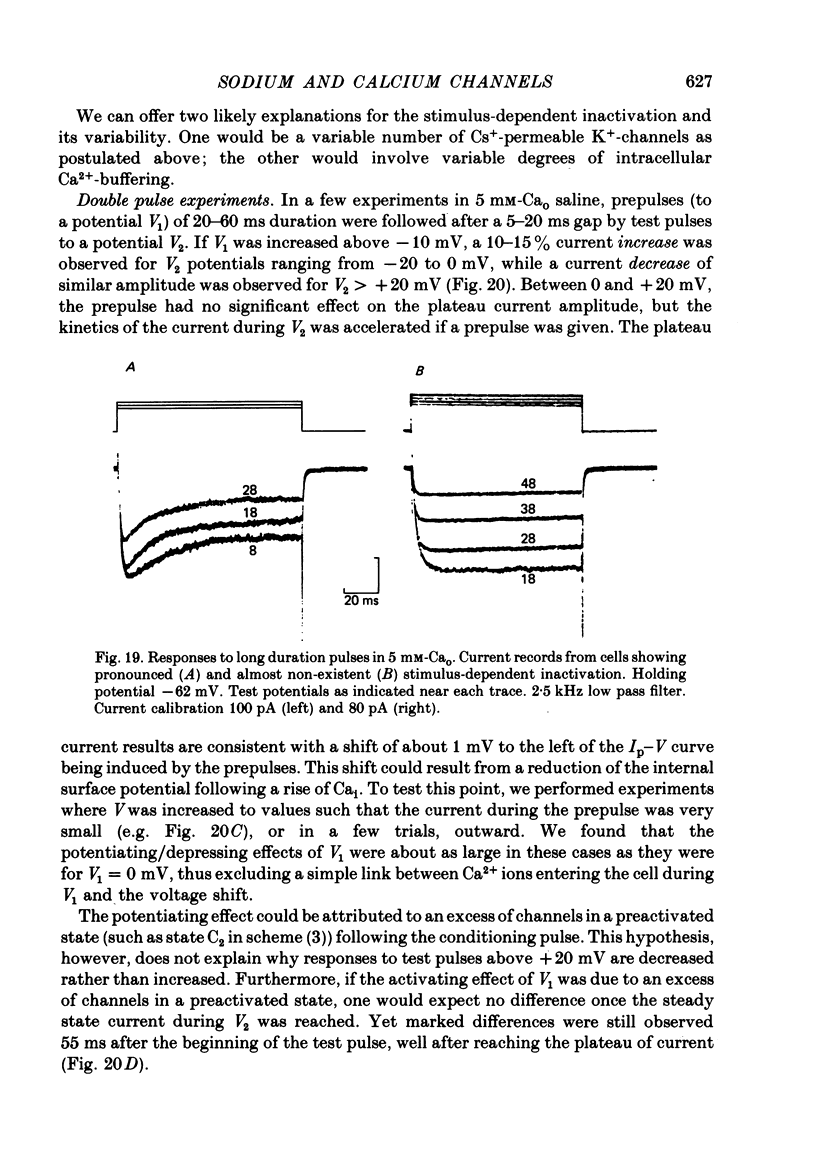
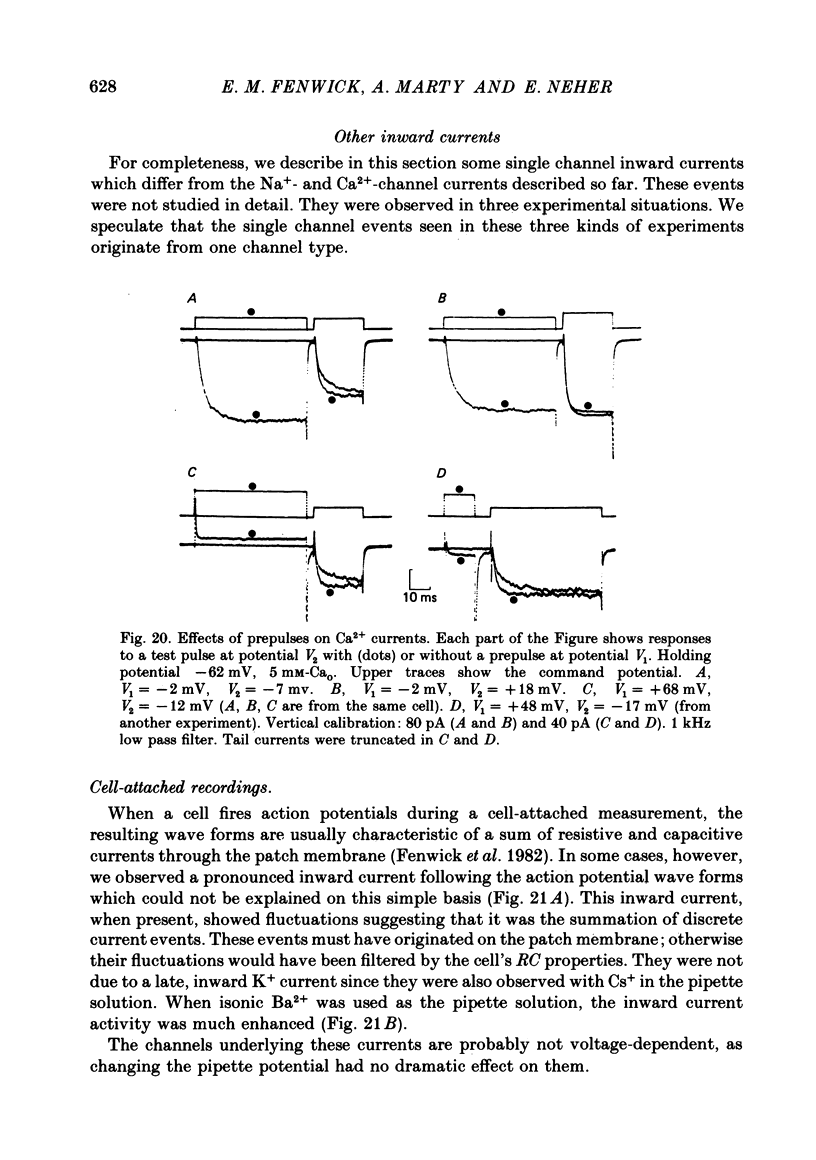
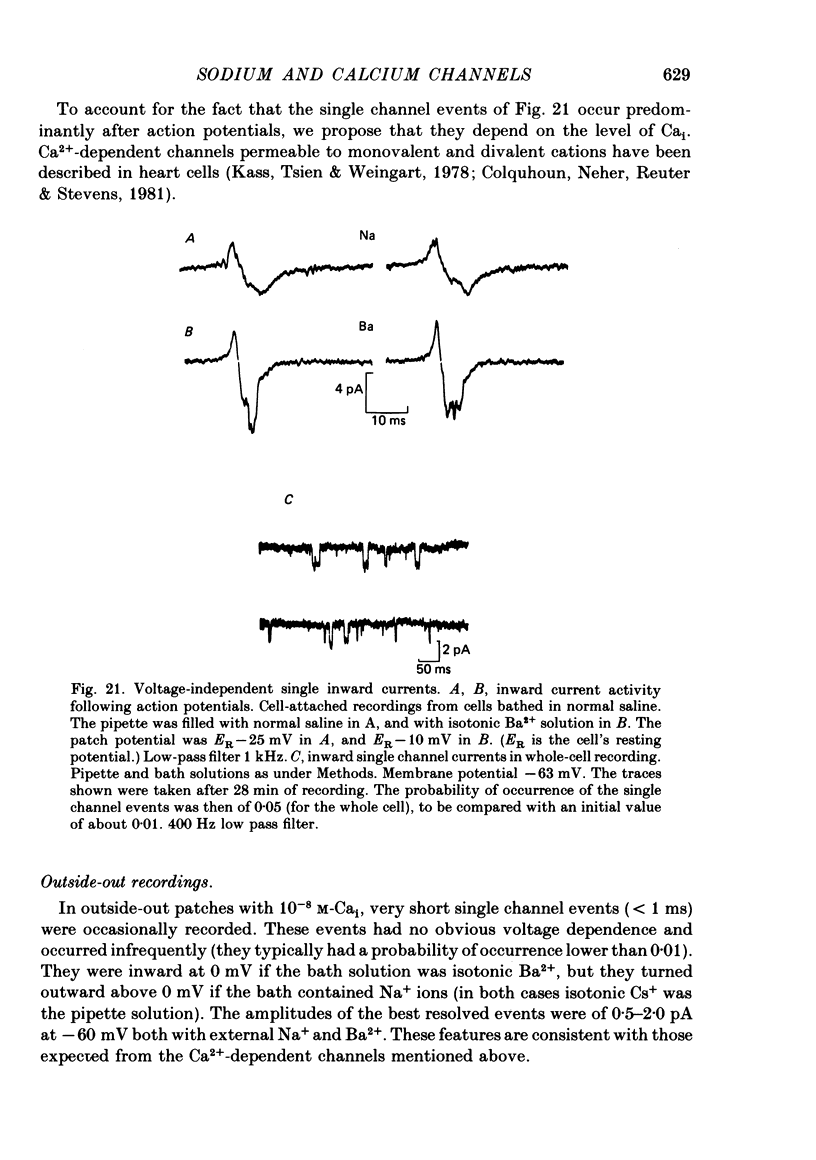
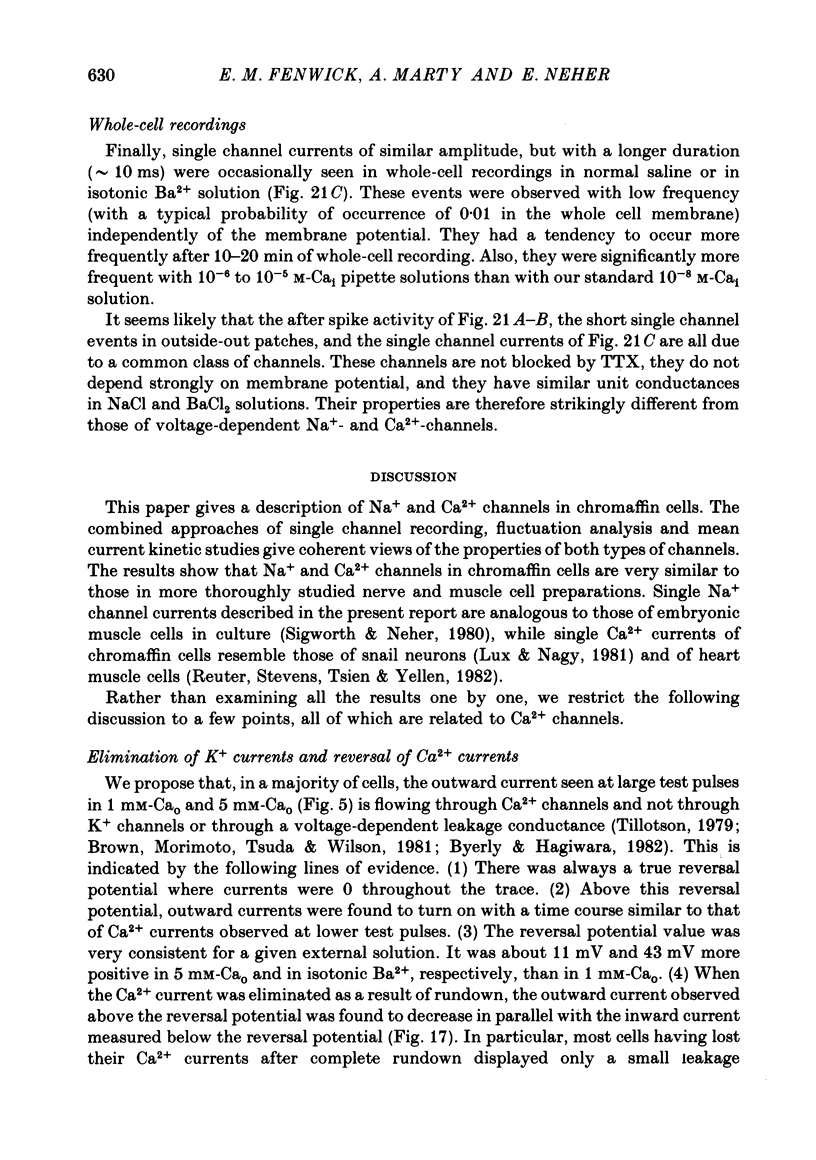
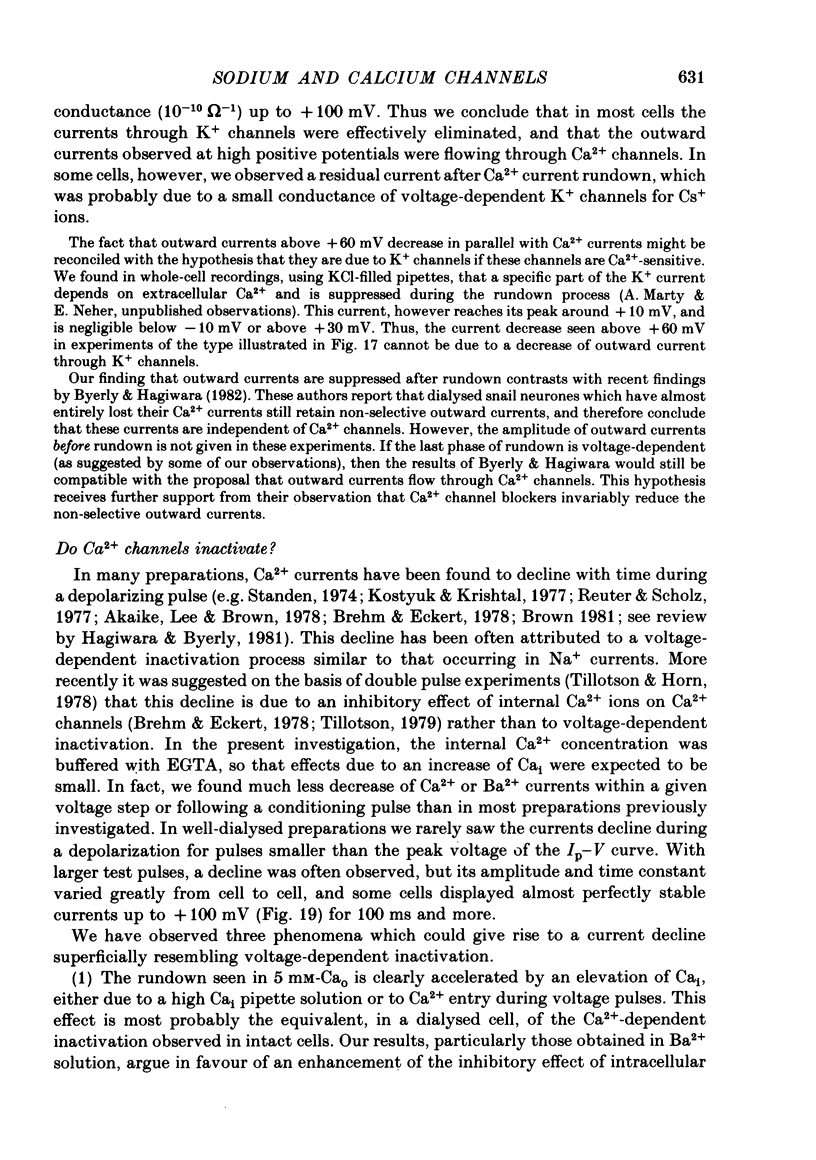
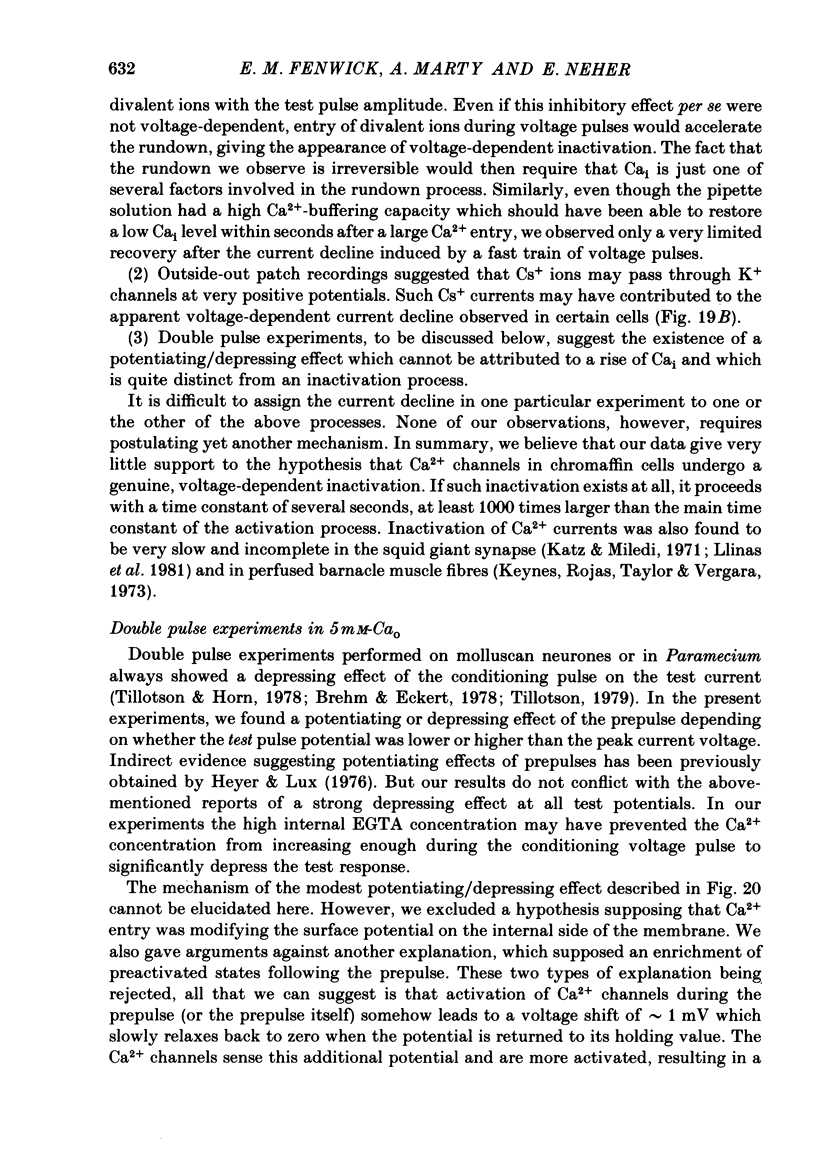
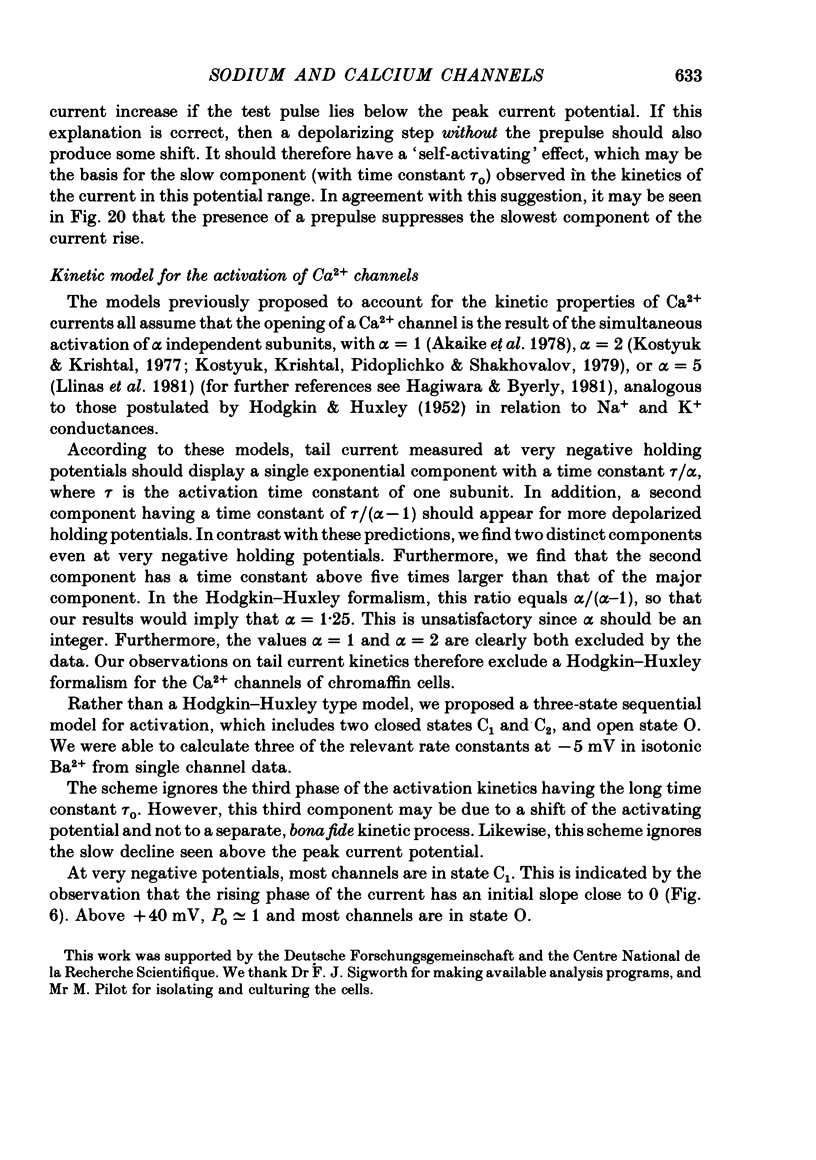
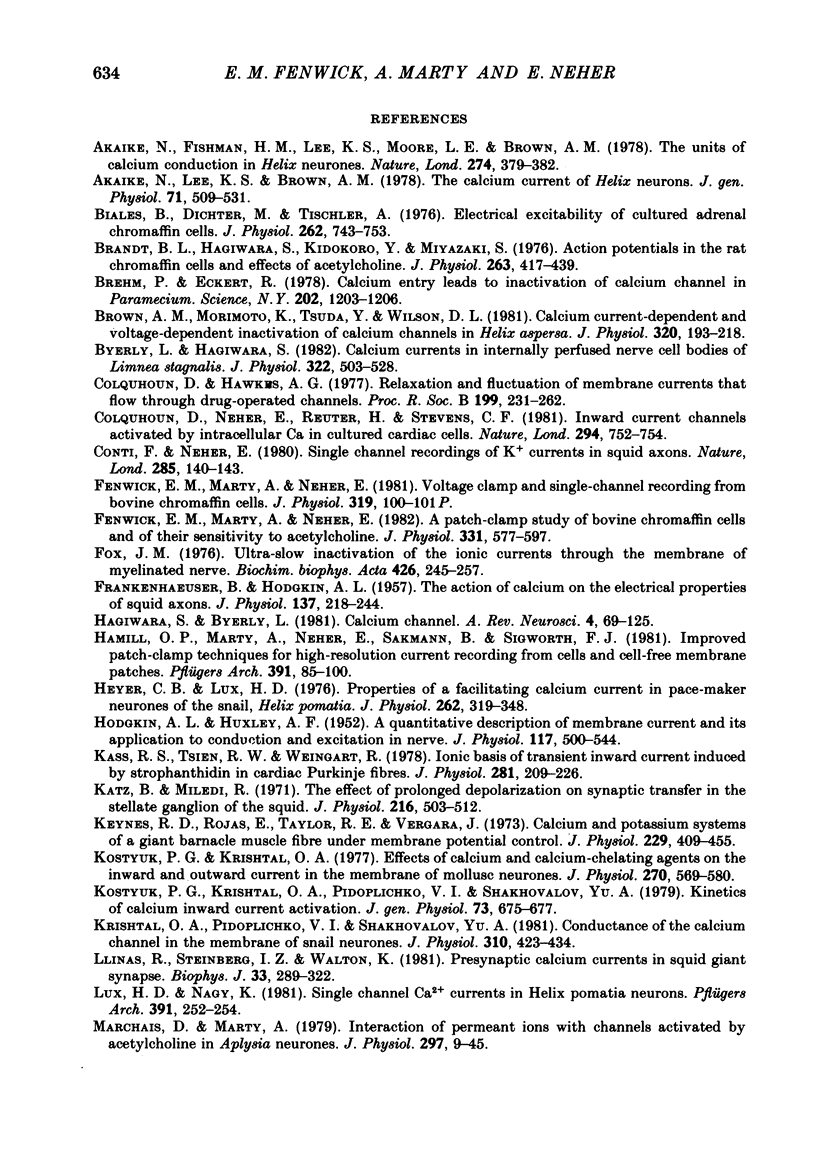
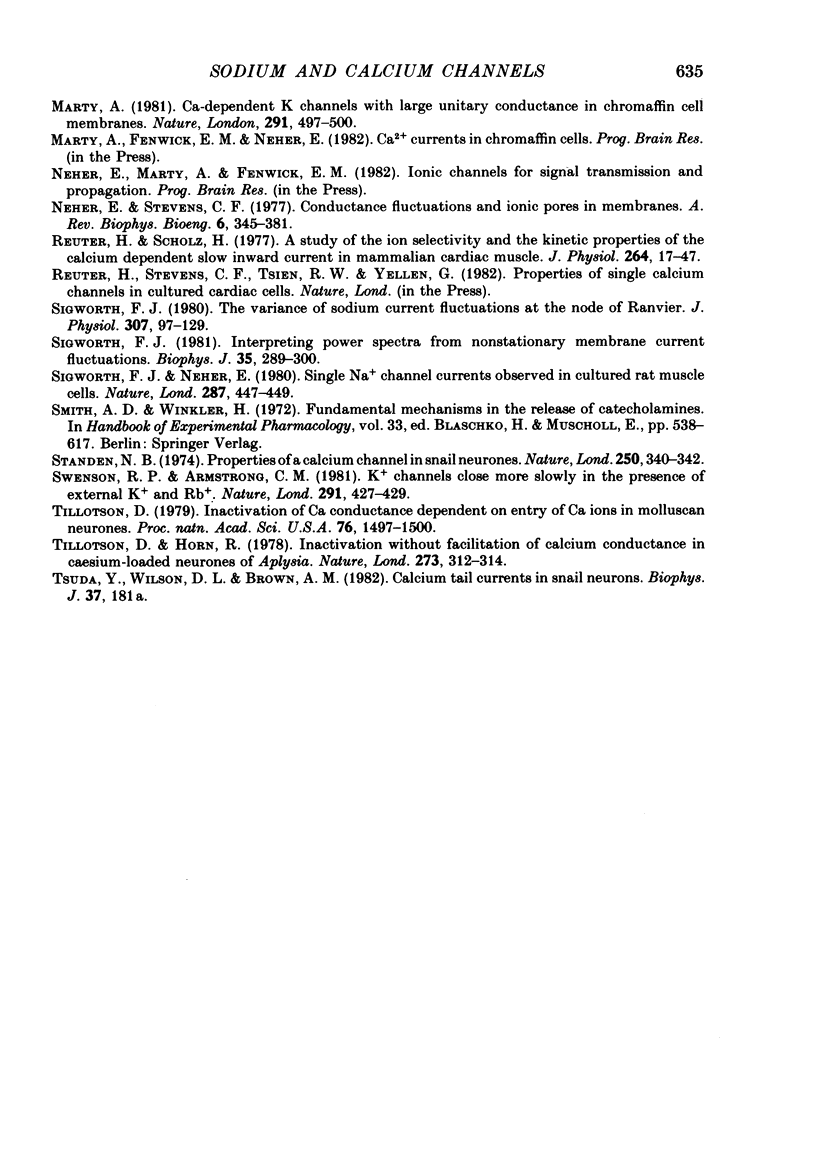
Selected References
These references are in PubMed. This may not be the complete list of references from this article.
- Akaike N., Fishman H. M., Lee K. S., Moore L. E., Brown A. M. The units of calcium conduction in Helix neurones. Nature. 1978 Jul 27;274(5669):379–382. doi: 10.1038/274379a0. [DOI] [PubMed] [Google Scholar]
- Akaike N., Lee K. S., Brown A. M. The calcium current of Helix neuron. J Gen Physiol. 1978 May;71(5):509–531. doi: 10.1085/jgp.71.5.509. [DOI] [PMC free article] [PubMed] [Google Scholar]
- Biales B., Dichter M., Tischler A. Electrical excitability of cultured adrenal chromaffin cells. J Physiol. 1976 Nov;262(3):743–753. doi: 10.1113/jphysiol.1976.sp011618. [DOI] [PMC free article] [PubMed] [Google Scholar]
- Brandt B. L., Hagiwara S., Kidokoro Y., Miyazaki S. Action potentials in the rat chromaffin cell and effects of acetylcholine. J Physiol. 1976 Dec;263(3):417–439. doi: 10.1113/jphysiol.1976.sp011638. [DOI] [PMC free article] [PubMed] [Google Scholar]
- Brehm P., Eckert R. Calcium entry leads to inactivation of calcium channel in Paramecium. Science. 1978 Dec 15;202(4373):1203–1206. doi: 10.1126/science.103199. [DOI] [PubMed] [Google Scholar]
- Brown A. M., Morimoto K., Tsuda Y., wilson D. L. Calcium current-dependent and voltage-dependent inactivation of calcium channels in Helix aspersa. J Physiol. 1981 Nov;320:193–218. doi: 10.1113/jphysiol.1981.sp013944. [DOI] [PMC free article] [PubMed] [Google Scholar]
- Byerly L., Hagiwara S. Calcium currents in internally perfused nerve cell bodies of Limnea stagnalis. J Physiol. 1982 Jan;322:503–528. doi: 10.1113/jphysiol.1982.sp014052. [DOI] [PMC free article] [PubMed] [Google Scholar]
- Colquhoun D., Hawkes A. G. Relaxation and fluctuations of membrane currents that flow through drug-operated channels. Proc R Soc Lond B Biol Sci. 1977 Nov 14;199(1135):231–262. doi: 10.1098/rspb.1977.0137. [DOI] [PubMed] [Google Scholar]
- Colquhoun D., Neher E., Reuter H., Stevens C. F. Inward current channels activated by intracellular Ca in cultured cardiac cells. Nature. 1981 Dec 24;294(5843):752–754. doi: 10.1038/294752a0. [DOI] [PubMed] [Google Scholar]
- Conti F., Neher E. Single channel recordings of K+ currents in squid axons. Nature. 1980 May 15;285(5761):140–143. doi: 10.1038/285140a0. [DOI] [PubMed] [Google Scholar]
- FRANKENHAEUSER B., HODGKIN A. L. The action of calcium on the electrical properties of squid axons. J Physiol. 1957 Jul 11;137(2):218–244. doi: 10.1113/jphysiol.1957.sp005808. [DOI] [PMC free article] [PubMed] [Google Scholar]
- Fenwick E. M., Marty A., Neher E. A patch-clamp study of bovine chromaffin cells and of their sensitivity to acetylcholine. J Physiol. 1982 Oct;331:577–597. doi: 10.1113/jphysiol.1982.sp014393. [DOI] [PMC free article] [PubMed] [Google Scholar]
- HODGKIN A. L., HUXLEY A. F. A quantitative description of membrane current and its application to conduction and excitation in nerve. J Physiol. 1952 Aug;117(4):500–544. doi: 10.1113/jphysiol.1952.sp004764. [DOI] [PMC free article] [PubMed] [Google Scholar]
- Hagiwara S., Byerly L. Calcium channel. Annu Rev Neurosci. 1981;4:69–125. doi: 10.1146/annurev.ne.04.030181.000441. [DOI] [PubMed] [Google Scholar]
- Hamill O. P., Marty A., Neher E., Sakmann B., Sigworth F. J. Improved patch-clamp techniques for high-resolution current recording from cells and cell-free membrane patches. Pflugers Arch. 1981 Aug;391(2):85–100. doi: 10.1007/BF00656997. [DOI] [PubMed] [Google Scholar]
- Heyer C. B., Lux H. D. Properties of a facilitating calcium current in pace-maker neurones of the snail, Helix pomatia. J Physiol. 1976 Nov;262(2):319–348. doi: 10.1113/jphysiol.1976.sp011598. [DOI] [PMC free article] [PubMed] [Google Scholar]
- Kass R. S., Tsien R. W., Weingart R. Ionic basis of transient inward current induced by strophanthidin in cardiac Purkinje fibres. J Physiol. 1978 Aug;281:209–226. doi: 10.1113/jphysiol.1978.sp012417. [DOI] [PMC free article] [PubMed] [Google Scholar]
- Katz B., Miledi R. The effect of prolonged depolarization on synaptic transfer in the stellate ganglion of the squid. J Physiol. 1971 Jul;216(2):503–512. doi: 10.1113/jphysiol.1971.sp009537. [DOI] [PMC free article] [PubMed] [Google Scholar]
- Keynes R. D., Rojas E., Taylor R. E., Vergara J. Calcium and potassium systems of a giant barnacle muscle fibre under membrane potential control. J Physiol. 1973 Mar;229(2):409–455. doi: 10.1113/jphysiol.1973.sp010146. [DOI] [PMC free article] [PubMed] [Google Scholar]
- Kostyuk P. G., Krishtal O. A. Effects of calcium and calcium-chelating agents on the inward and outward current in the membrane of mollusc neurones. J Physiol. 1977 Sep;270(3):569–580. doi: 10.1113/jphysiol.1977.sp011969. [DOI] [PMC free article] [PubMed] [Google Scholar]
- Kostyuk P. G., Krishtal O. A., Pidoplichko V. I., Shakhovalov YuA Kinetics of calcium inward current activation. J Gen Physiol. 1979 May;73(5):675–680. doi: 10.1085/jgp.73.5.675. [DOI] [PMC free article] [PubMed] [Google Scholar]
- Krishtal O. A., Pidoplichko V. I., Shakhovalov Y. A. Conductance of the calcium channel in the membrane of snail neurones. J Physiol. 1981 Jan;310:423–434. doi: 10.1113/jphysiol.1981.sp013558. [DOI] [PMC free article] [PubMed] [Google Scholar]
- Llinás R., Steinberg I. Z., Walton K. Presynaptic calcium currents in squid giant synapse. Biophys J. 1981 Mar;33(3):289–321. doi: 10.1016/S0006-3495(81)84898-9. [DOI] [PMC free article] [PubMed] [Google Scholar]
- Lux H. D., Nagy K. Single channel Ca2+ currents in Helix pomatia neurons. Pflugers Arch. 1981 Sep;391(3):252–254. doi: 10.1007/BF00596179. [DOI] [PubMed] [Google Scholar]
- Marchais D., Marty A. Interaction of permeant ions with channels activated by acetylcholine in Aplysia neurones. J Physiol. 1979 Dec;297(0):9–45. doi: 10.1113/jphysiol.1979.sp013025. [DOI] [PMC free article] [PubMed] [Google Scholar]
- Marty A. Ca-dependent K channels with large unitary conductance in chromaffin cell membranes. Nature. 1981 Jun 11;291(5815):497–500. doi: 10.1038/291497a0. [DOI] [PubMed] [Google Scholar]
- Neher E., Stevens C. F. Conductance fluctuations and ionic pores in membranes. Annu Rev Biophys Bioeng. 1977;6:345–381. doi: 10.1146/annurev.bb.06.060177.002021. [DOI] [PubMed] [Google Scholar]
- Neumcke B., Fox J. M., Drouin H., Schwarz W. Kinetics of the slow variation of peak sodium current in the membrane of myelinated nerve following changes of holding potential or extracellular pH. Biochim Biophys Acta. 1976 Mar 5;426(2):245–257. doi: 10.1016/0005-2736(76)90335-7. [DOI] [PubMed] [Google Scholar]
- Reuter H., Scholz H. A study of the ion selectivity and the kinetic properties of the calcium dependent slow inward current in mammalian cardiac muscle. J Physiol. 1977 Jan;264(1):17–47. doi: 10.1113/jphysiol.1977.sp011656. [DOI] [PMC free article] [PubMed] [Google Scholar]
- Sigworth F. J. Interpreting power spectra from nonstationary membrane current fluctuations. Biophys J. 1981 Aug;35(2):289–300. doi: 10.1016/S0006-3495(81)84790-X. [DOI] [PMC free article] [PubMed] [Google Scholar]
- Sigworth F. J., Neher E. Single Na+ channel currents observed in cultured rat muscle cells. Nature. 1980 Oct 2;287(5781):447–449. doi: 10.1038/287447a0. [DOI] [PubMed] [Google Scholar]
- Sigworth F. J. The variance of sodium current fluctuations at the node of Ranvier. J Physiol. 1980 Oct;307:97–129. doi: 10.1113/jphysiol.1980.sp013426. [DOI] [PMC free article] [PubMed] [Google Scholar]
- Standen N. B. Properties of a calcium channel in snail neurones. Nature. 1974 Jul 26;250(464):340–342. doi: 10.1038/250340a0. [DOI] [PubMed] [Google Scholar]
- Swenson R. P., Jr, Armstrong C. M. K+ channels close more slowly in the presence of external K+ and Rb+. Nature. 1981 Jun 4;291(5814):427–429. doi: 10.1038/291427a0. [DOI] [PubMed] [Google Scholar]
- Tillotson D., Horn R. Inactivation without facilitation of calcium conductance in caesium-loaded neurones of Aplysia. Nature. 1978 May 25;273(5660):312–314. doi: 10.1038/273312a0. [DOI] [PubMed] [Google Scholar]
- Tillotson D. Inactivation of Ca conductance dependent on entry of Ca ions in molluscan neurons. Proc Natl Acad Sci U S A. 1979 Mar;76(3):1497–1500. doi: 10.1073/pnas.76.3.1497. [DOI] [PMC free article] [PubMed] [Google Scholar]


